Better Sailing
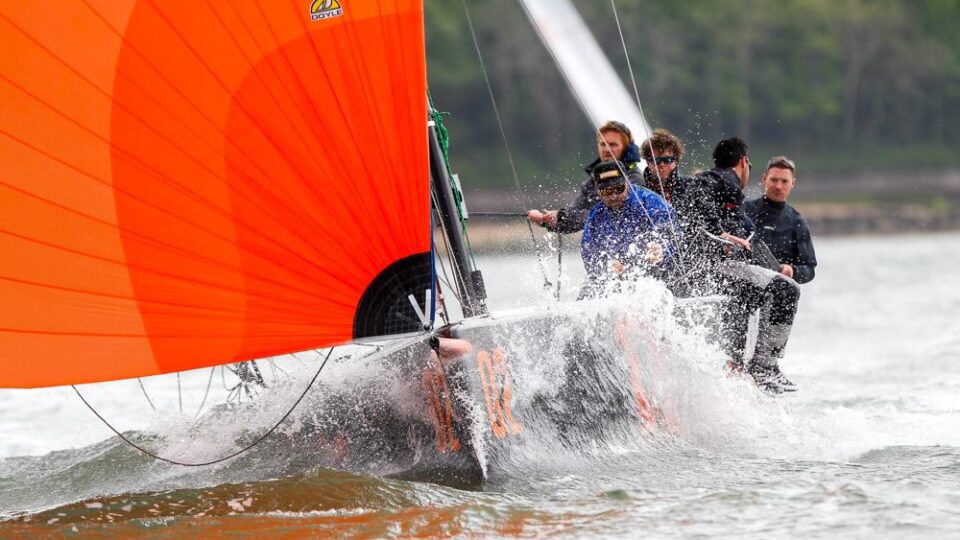

Sailing Crew Roles and Names
The skipper is responsible for the safety of the yacht and the crew’s welfare. However, sailing a boat successfully requires teamwork from the skipper and the crew. This will ensure that all maneuvers—such as leaving a mooring, hoisting sails, changing tacks, reefing, or entering a marina—can be completed with maximum enjoyment and minimum stress.
Boat Captain/Skipper
It may come as a shock, but the skipper is not necessarily the helm. This crew member must ensure that the boat is ready for sailing. He or she needs to make sure that all members of the crew are accounted for. They also need to make sure that food and fuel are sufficient, and sails are ready for hoisting. The skipper is in charge of keeping communications open onboard and help other crew members if needed. Also, they are usually responsible for talking the whole crew through maneuvers as they are about to happen and making sure that all crew members are ready.
What Makes A Good Skipper?
- Responsibility : The skipper is responsible for all aspects of the running of the yacht, its safety, and the crew’s wellbeing.
- Skills : He or she should be comfortable with sailing and navigation skills, inspire confidence in their crew, and be a good communicator.
- Delegation : A good skipper should keep on top of all his or her duties and give the crew tasks that are appropriate to their experience.
- Patience : He or she should be patient with inexperienced crew members and be able to run the yacht with a light touch while retaining respect and authority.
- Briefing : It is the skipper’s role to plan the passage in detail before setting sail.
- Involvement : A good skipper will also encourage the crew to get involved in passage planning and navigation and will always listen to their opinions.
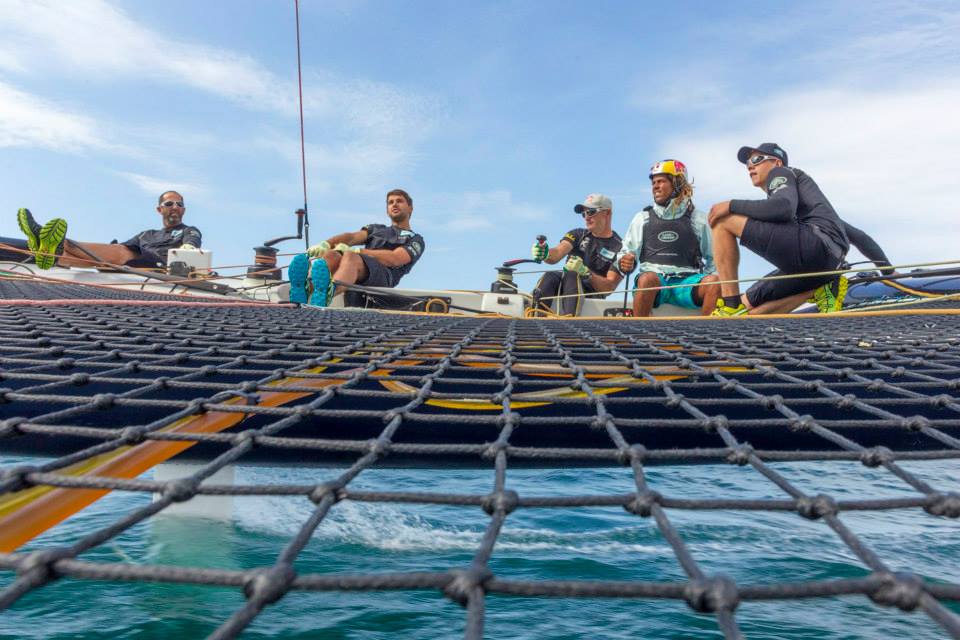
Tactician
The tactician’s role is to get the boat around the racecourse as fast as possible. For that, he needs to take into account the wind, tide, and other competitors, as well as the crew’s ability. They also need to make sure that the boat has the correct course. In short, the tactician is the brains of the sailboat. The tactician must communicate with the helm and skipper to run through maneuvers.
The Helm (Driver)
The Helm is often mistakenly perceived as the skipper. This crew role is to steer the boat where the tactician says and to keep sailing as fast as possible. The helm is also helping with other tasks, but they must focus on the job at hand as much as possible. The helm and the tactician must be in close communication with each other.
Head Sail Trimmers
This crew role is for two members, one who will cut release the sail when going through the tack while the other pulls in the full sail. The crew member releasing can then assist with tailing the sail or trimming it – which is a good example of teamwork. Also, the trimmer should keep adjusting the sail, depending on the point of sail, and should be very focused on that task. Also, the trimmers are in charge of trimming the spinnaker sail and guy when going downwind. Main communication is kept between each other, boat captain and tactician. Pre-start these guys will have a lot to do!
This crew member is in control of all sail hoists and drops depending on the wind. The bowman spends most of their time on the foredeck (the deck at the forward part of the sailboat), preparing for spinnaker hoists, gibes, and drops.
This crew member is a combination of both the bowman and mastman. They are in control of all of the running rigging which comes into the cockpit. This is a vital role and always in the middle of the action. Pitmans must keep communication is between bowman, mast man, and skipper—the eyes and ears for the foredeck crew.
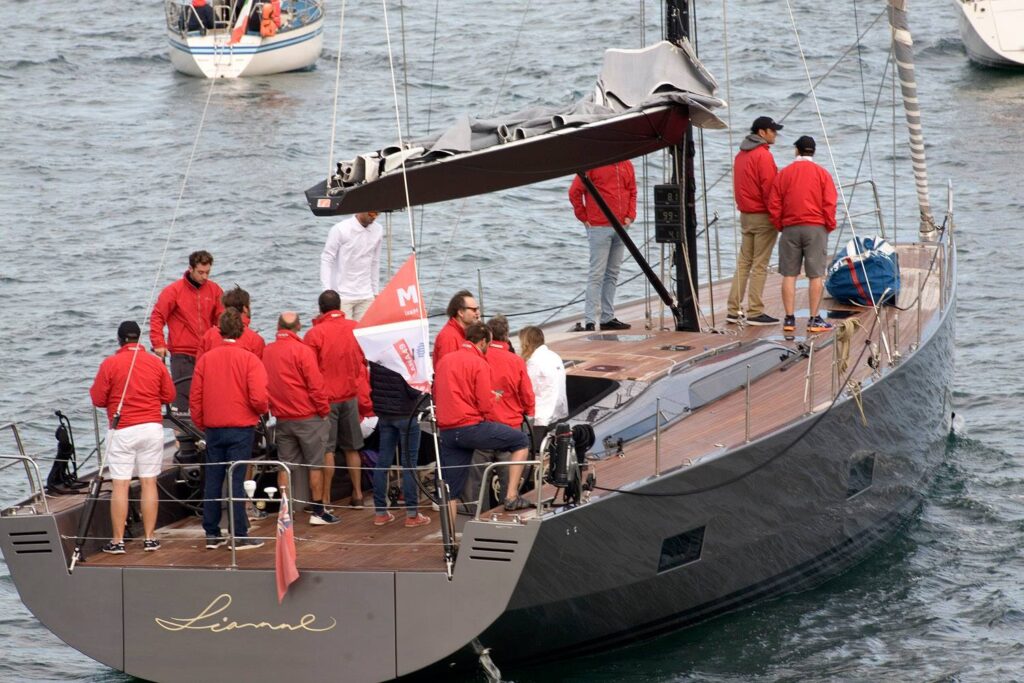
This position is reserved for the stronger members of the crew. A mastman’s foremost task is to assist with the speedy hoisting of the sails during maneuvers. The mast man and bowman go hand in hand and help each other on hoists and drops. The main communication is with the bowman, pitman, and skipper.
No sailing team is complete without its ballast crew members that help to balance the boat in order to reach its top possible speeds and maneuverability. These members of the crew are called ‘ballast’ and are key when racing for the mark. Ballast crew members have the best seat in the house.
What Makes a Good Crew Member?
- Key qualities : All crew members require a positive attitude, sense of humor, and the ability to get along with others in the confined space aboard a cruiser.
- Willingness to Learn : Good crew members are willing to learn and to take an active role in all aspects of running the yacht.
- Attentive : Diligent crew listen to the instructions carefully and ask questions if they do not understand anything.
- Working As a Team : All members of the crew must remember that they are part of a team. A happy gathering in the cockpit at the end of the passage is an indicator that each member of the crew has done their job.
Peter is the editor of Better Sailing. He has sailed for countless hours and has maintained his own boats and sailboats for years. After years of trial and error, he decided to start this website to share the knowledge.
Related Posts

Atlantic vs Pacific: Which is More Dangerous for Sailing?

Why Do Sailboats Lean?

How Does a Boat Sail Upwind? Unveiling the Mechanics of Against the Wind Sailing

How Does Sailing Work? The Physics of Sailing
- Buyer's Guide
- Destinations
- Maintenance
- Sailing Info
Hit enter to search or ESC to close.

300+ Nautical Team Names

Are you in search of the perfect nautical team name for your group? Look no further! In this blog, we will dive into the world of nautical team names and provide you with a comprehensive list of the best crew names to set sail with. Whether you’re part of a sailing team, a boating club, or just a group of friends who love the ocean, having a catchy and memorable team name can add a sense of camaraderie and excitement to your adventures. So, get ready to embark on a journey to find the perfect nautical team name that will make your group stand out from the rest!
Catchy Nautical Team Names
1. ⚓️ Anchors Aweigh 2. Wave Riders 3. Sea Explorers 4. Ocean Warriors 5. ⛵️ Sail Away Squad 6. Neptune’s Crew 7. Sea Stars 8. ⚓️ Mariner Mavericks 9. ♀️ Rowing Rebels 10. Shell Seekers 11. ⛵️ Wind Chasers 12. Tidal Titans 13. Whale Watchers 14. ⚓️ Captain’s Crew 15. Buoyant Buccaneers 16. Fishermen’s Finest 17. ⛵️ Sailing Seagulls 18. Triton’s Tribe 19. Octo-Squad 20. ⚓️ Sea Serpents 21. Aqua Adventurers 22. Dolphin Dashers 23. ⛵️ Regatta Racers 24. Mermaid Maniacs 25. Flipper Fanatics
Creative Nautical Team Names
1. The Salty Sea Dogs ⚓️ 2. The Wave Warriors ️ 3. The Anchor Avengers ⚓️ ♂️ 4. The Siren Sailors ♀️⛵️ 5. The Buoyant Buccaneers ☠️ ♂️ 6. The Mariner Mavericks 7. The Captain’s Crew ✈️ ✈️ 8. The Seafaring Squad 9. The Ocean Explorers 10. The Tidal Titans 11. The Aquatic Adventurers 12. The Nautical Nomads ⚓️ 13. The Sailfish Squad ⛵️ 14. The Mermaid Mates ♀️ ♀️ 15. The Yacht Yahoos ️ 16. The Poseidon’s Posse 17. The Nautical Navigators ⚓️ 18. The Shipshape Sailors ⛵️✨ 19. The Wave Whispers ️ 20. The Seashell Seekers 21. The Saltwater Surfers ♂️ 22. The Marlin Masters 23. The Coastal Captains ✈️ 24. The Lighthouse Legends 25. The Sailor’s Delight ⛵️
Classic Nautical Team Names
1. ⚓️ The Salty Seamen 2. The Wave Riders 3. The Dolphin Divers 4. The Ocean Explorers 5. ⛵️ The Sailing Savages 6. The Shell Seekers 7. The Sea Serpents 8. ⚓️ The Anchors Away 9. The Whale Watchers 10. The Tidal Titans 11. ⛵️ The Regatta Racers 12. The Marlin Masters 13. The Surfing Sailors 14. ⚓️ The Buoyant Buccaneers 15. The Humpback Heroes 16. The Oceanic Outlaws 17. ⛵️ The Yacht Yahoos 18. The Finned Friends 19. The Nautical Navigators 20. ⚓️ The Shipshape Squad 21. The Kraken Crew 22. The Seafaring Strikers 23. ⛵️ The Jolly Sailors 24. The Pufferfish Pirates 25. The Aquatic Adventurers
Fun Nautical Team Names
1. The Salty Sailors ⛵️ 2. The Wave Warriors 3. The Anchors Aweigh ⚓️ 4. The Sea Sirens ♀️ 5. The Ship Shape Crew 6. The Buoyant Buccaneers ☠️ 7. The Aquatic Avengers ♂️ 8. The Mariner Mavericks 9. The Oceanic Outlaws 10. The Tidal Titans 11. The Nautical Ninjas 12. The Seafaring Superstars ⭐️⛵️ 13. The Captain’s Crew ✈️ 14. The Mermaid Maniacs ♀️ 15. The Sailfish Squad ⛵️ 16. The Yacht Yardbirds 17. The Aquaholics 18. The Shipwrecked Souls ☠️ 19. The Nautical Navigators ⛵️ 20. The Seashell Squad 21. The Maritime Mates ⚓️ 22. The Ocean Odyssey 23. The Fisherman’s Friends 24. The Sailor Scouts ⚓️ ♀️ 25. The Seaworthy Squad ✨
Popular Nautical Team Names
1. Anchors Aweigh ⚓️ 2. The Salty Sea Dogs 3. The Wave Riders 4. The Shipmates 5. The Buoyant Buccaneers ☠️ 6. The Sailing Seagulls 7. The Nautical Navigators 8. The Mariner’s Crew ✈️ 9. The Aquatic Adventurers 10. The Captain’s Mates ✈️ 11. The Deep Sea Divers 12. The Maritime Mermaids ♀️ 13. The Ocean Explorers 14. The Tidal Titans 15. The Sailfish Squad 16. The Seafaring Sailors ⛵️ 17. The Lighthouse Legends 18. The Coastal Commanders 19. The Fisherman’s Friends 20. The Marlin Masters 21. The Pelagic Pirates ☠️ 22. The Aquaholics 23. The Regatta Rebels 24. The Yacht Yahoos ️ 25. The Seashell Seekers
Funny Nautical Team Names
1. The Salty Seamen ⚓️ 2. The Shipfaced Sailors 3. The Buoyant Buccaneers ☠️ 4. The Knot-So-Serious Sailors 5. The Jolly Jellyfish 6. The S.S. LOL 7. The Anchors Aweigh-holes ⚓️ 8. The Laughing Lobsters 9. The Sea-nile Sailors 10. The Wacky Whalers 11. The Aye-Aye Pirates ☠️ 12. The Nautical Nuts 13. The Shipshape Shenanigans ⛵️ 14. The Seaworthy Scallywags ☠️ 15. The Laughing Lighthouse Keepers 16. The Fishy Fools 17. The S.S. Chuckles 18. The Hilarious Harpooners 19. The Anchors of Anarchy ⚓️ 20. The Seafaring Stand-up Comedians 21. The Belly-laughing Buccaneers ☠️ 22. The S.S. Giggles ⛵️ 23. The Sailing Slapstickers 24. The Nautical Nitwits 25. The Laugh-a-Lot Lifeguards
Cute Nautical Team Names
1. Anchors Aweigh ⚓️ 2. Seashell Squad 3. Mermaid Mariners ♀️ 4. Sailor Sweethearts ⛵️ 5. Nautical Cuties 6. Oceanic Dreamers 7. Wave Riders ♀️ 8. Captain Cuddles ✈️ 9. Shipshape Smiles ⚓️ 10. Salty Kisses 11. Beachcomber Babes ♀️ 12. Buoyant Beauties ♀️ 13. Siren Sisters ♀️ 14. Lighthouse Lovers ❤️ 15. Sail Away Sweeties ⛵️ 16. Nautical Hugs 17. Sea Star Squad 18. Mariner Munchkins ⚓️ 19. Captain’s Crew ✈️ ✈️ 20. Beachy Belles 21. Ocean Explorers 22. Shipshape Darlings ⚓️ 23. Sailor Scouts ⛵️ ♀️ 24. Seafaring Sweeties 25. Mermaid Mates ♀️ ♀️
Unique Nautical Team Names
1. ⚓️ Anchors Aweigh 2. Wave Riders 3. Sea Serpents 4. Shark Bait 5. Aquaholics 6. ⛵️ Sailing Seagulls 7. Fin-tastic Sailors 8. Ocean Explorers 9. Pirate Parrots 10. ⚓️ Captain’s Crew 11. Whale Watchers 12. Tidal Titans 13. Crusty Buccaneers 14. ⛵️ Wind Chasers 15. Shell Seekers 16. Mermaid Maniacs 17. Dolphin Divas 18. ⚓️ Nautical Navigators 19. Sailfish Squad 20. Hammerhead Heroes 21. Fishy Friends 22. ⛵️ Buoyant Buccaneers 23. Sea Sirens 24. Crabby Crew 25. ⚓️ Mariner Mavericks
Clever Nautical Team Names
1. ⚓️ The Salty Sea Dogs 2. The Wave Riders 3. The Oceanic Explorers 4. The Shark Bait 5. ⛵️ The Sailing Savants 6. The Fishermen’s Finest 7. The Speedy Sailors 8. The Tidal Titans 9. The Kraken Crew 10. The Island Hoppers 11. The Whales of the Water 12. ⚓️ The Anchors Aweigh 13. The Sea Sirens 14. The Crabby Captains 15. The Shell Seekers 16. The Marlin Masters 17. ☠️ The Pirate’s Parley 18. The Mermaid’s Melody 19. The Leviathan Legends 20. The Palm Tree Pirates 21. The Seafaring Scoundrels 22. ⚓️ The Buoyant Buccaneers 23. The Cresting Currents 24. The Pufferfish Pals 25. The Shipshape Sailors
Cool Nautical Team Names
1. ⚓️ The Salty Sailors 2. The Wave Riders 3. The Ocean Explorers 4. The Shipshape Crew 5. The Aquatic Adventurers 6. The Island Hoppers 7. The Kraken Killers 8. The Sunseekers 9. The Whale Watchers 10. ☠️ The Pirate Posse 11. The Shark Attackers 12. The Sunset Sailing Squad 13. The Seashell Seekers 14. ⛵️ The Wind Whisperers 15. ♀️ The Surfin’ Seafarers 16. The Parrot Pirates 17. The Palm Tree Pirates 18. The Tsunami Chasers 19. The Beach Bums 20. The Dolphin Dashers 21. The Octo-Squad 22. The Horizon Hunters 23. The Crabby Crew 24. The Tidal Titans 25. ♀️ The Rowing Rebels
Best Nautical Team Names
1. ⚓️ Anchors Aweigh 2. Wave Riders 3. Sea Explorers 4. Sail Away 5. Ocean Warriors 6. Fishermen’s Crew 7. ⛵️ Sailing Seagulls 8. Whale Watchers 9. Tidal Titans 10. ♀️ Rowing Rebels 11. Shell Seekers 12. ⚓️ Captain’s Crew 13. Surfing Sailors 14. Deep Sea Divers 15. Speedy Dolphins 16. Mermaid’s Squad 17. Mighty Mariners 18. ⛵️ Wind Chasers 19. Saltwater Sailors 20. Flipper’s Friends 21. ♀️ Oar Paddlers 22. Nautical Navigators 23. Aquatic Adventurers 24. ⚓️ Buoyant Buccaneers 25. Tidal Trekkers
Awesome Nautical Team Names
1. Sea Warriors ⚓️ 2. Wave Riders 3. Ocean Explorers 4. Ship Shape ⛵️ 5. Aquatic Avengers 6. Saltwater Squad 7. Tidal Titans 8. Mariner Mavericks ⚓️ 9. Sailors of Fortune ⛵️ 10. Nautical Knights ⚔️⚓️ 11. Deep Sea Divas 12. Buoyant Buccaneers ⚓️ 13. Anchor Angels ⚓️ 14. Poseidon’s Posse ♂️ 15. Maritime Masters ⚓️ 16. Sailfish Squad ⛵️ 17. Captain’s Crew ⚓️ 18. Seafaring Superstars ⚓️✨ 19. Salty Seagulls 20. Oceanic Outlaws ☠️ 21. Mermaid Mariners ♀️ 22. Shipwreck Survivors ⛵️ 23. Aquaholics Anonymous 24. Sail Away Sisters ⛵️ 25. Deep Diving Dolphins
Favourite Nautical Team Names
1. The Salty Sea Dogs ⚓️ 2. The Wave Riders 3. The Buoyant Buccaneers ☠️ 4. The Mariner Mavericks ⛵️ 5. The Aquatic Anchors ⚓️ 6. The Siren Sailors ♀️ 7. The Nautical Navigators 8. The Oceanic Outlaws ☠️ 9. The Seafaring Sharks 10. The Captain’s Crew ⚓️ 11. The Tidal Titans 12. The Mermaid Mates ♀️ 13. The Sailfish Squad 14. The Maritime Marauders ☠️ 15. The Seaworthy Swashbucklers ⚓️ 16. The Dolphin Divers 17. The Kraken Killers 18. The Coastal Crusaders 19. The Shipshape Strikers ⚓️ 20. The Aquatic Avengers 21. The Nautical Ninjas ☠️ 22. The Seagull Squad 23. The Mermaid Mania ♀️ 24. The Salty Surfers 25. The Ocean Explorers
Good Nautical Team Names
1. ⚓️ The Salty Seafarers 2. The Aqua Adventurers 3. The Wave Riders 4. The Shipshape Sailors 5. The Mighty Mariners 6. ⛵️ The Wind Whisperers 7. The Shell Seekers 8. The Ocean Explorers 9. The Tidal Titans 10. The Speedy Skippers 11. The Island Hoppers 12. The Fishermen’s Fleet 13. ⚓️ The Anchor Allies 14. The Surfing Squad 15. ♀️ The Rowing Rascals 16. The Yacht Yahoos 17. The Sea Creatures 18. ⛵️ The Sailing Sensations 19. The Tentacled Team 20. The Tsunami Tribe 21. The Shipmates 22. The Whale Watchers 23. The Palm Pirates 24. ⚓️ The Buoyant Bunch 25. The Jet Ski Junkies
The role of crew positions and duties on a sailboat
Discover the key crew positions and their duties on a sailboat to ensure a safe and enjoyable journey exploring the open sea with your family.
The Role of Crew Positions and Duties on a Sailboat
Sailing is an exciting and fulfilling way to explore the world with your family, but it’s also a complex endeavor that requires a solid understanding of various crew positions and duties. In this article, we’ll delve into the different roles on a sailboat, their responsibilities, and how they contribute to a successful sailing adventure.
Table of Contents
Introduction, watch leader, galley crew, communications officer.
Before we dive into the specific crew positions, it’s important to note that the size and complexity of your sailboat will determine the number of crew members needed. On a smaller boat, one person may take on multiple roles, while larger boats may require a full crew to operate efficiently. Regardless of your boat’s size, understanding the various roles and their duties will help ensure a safe and enjoyable sailing experience.
The skipper, also known as the captain, is the person in charge of the sailboat. They are responsible for the overall safety and well-being of the crew and the vessel. The skipper’s duties include:
- Planning and executing the sailing itinerary
- Ensuring the boat is properly maintained and equipped
- Making decisions regarding navigation, weather, and safety
- Managing the crew and assigning tasks
- Ensuring all crew members are trained and competent in their roles
- Handling emergencies and making critical decisions under pressure
The skipper should have extensive sailing experience, strong leadership skills, and a thorough understanding of the boat’s systems and capabilities.
The first mate, or mate, is the skipper’s right-hand person and is responsible for assisting with the management of the boat and crew. The first mate’s duties include:
- Assisting the skipper with navigation, weather, and safety decisions
- Supervising and directing the crew in their tasks
- Stepping in as skipper if the skipper is incapacitated or unavailable
The first mate should have strong sailing skills, good communication and leadership abilities, and a solid understanding of the boat’s systems and capabilities.
The navigator is responsible for planning and executing the boat’s course, taking into account factors such as weather, currents, and hazards. The navigator’s duties include:
- Creating and updating the boat’s passage plan
- Monitoring the boat’s position and progress using charts, GPS, and other navigational tools
- Identifying and avoiding potential hazards, such as reefs, shoals, and shipping traffic
- Communicating with the skipper and crew regarding the boat’s course and any necessary adjustments
The navigator should have strong navigational skills, a keen eye for detail, and the ability to think critically and make decisions under pressure.
On longer passages, the crew will typically be divided into watches, with each watch responsible for sailing the boat for a set period of time. The watch leader is responsible for overseeing their watch and ensuring the boat is sailed safely and efficiently. The watch leader’s duties include:
- Ensuring the crew on watch is performing their tasks correctly and efficiently
- Monitoring the boat’s course, speed, and sail trim
- Communicating with the skipper and other watch leaders regarding the boat’s progress and any issues that arise
- Ensuring the crew on watch is well-rested and alert
The watch leader should have strong sailing skills, good communication and leadership abilities, and the ability to make decisions under pressure.
The helm, or helmsperson, is responsible for steering the boat and maintaining its course. The helm’s duties include:
- Steering the boat according to the navigator’s instructions
- Monitoring the boat’s speed and adjusting the sails as needed to maintain optimal performance
- Communicating with the crew regarding sail trim and other adjustments
- Keeping a lookout for potential hazards and other vessels
The helm should have strong sailing skills, good communication abilities, and a keen sense of awareness.
Deckhands are responsible for handling the sails, lines, and other equipment on the boat. Deckhand duties include:
- Hoisting, lowering, and trimming sails
- Tying and adjusting lines, such as halyards, sheets, and dock lines
- Assisting with anchoring and mooring the boat
- Performing routine maintenance tasks, such as cleaning and inspecting the rigging
Deckhands should have a basic understanding of sailing and be able to follow instructions and work well as part of a team.
The galley crew is responsible for preparing meals and maintaining the cleanliness and organization of the boat’s galley (kitchen). Galley crew duties include:
- Planning and preparing meals for the crew
- Ensuring the galley is clean and well-stocked
- Managing food storage and waste disposal
- Assisting with other tasks as needed, such as cleaning and maintenance
Galley crew members should have good cooking skills, be well-organized, and able to work efficiently in a small space.
The engineer is responsible for maintaining and repairing the boat’s mechanical, electrical, and plumbing systems. Engineer duties include:
- Performing routine maintenance on the engine, generator, and other systems
- Diagnosing and repairing mechanical, electrical, and plumbing issues
- Ensuring the boat’s systems are operating efficiently and safely
- Assisting with other tasks as needed, such as sail handling and deck work
The engineer should have a strong technical background, good problem-solving skills, and a thorough understanding of the boat’s systems.
The communications officer is responsible for managing the boat’s communication systems, including radios, satellite phones, and internet access. Communications officer duties include:
- Monitoring and operating the boat’s communication systems
- Ensuring the crew is aware of and follows proper communication protocols
- Communicating with other vessels, marinas, and authorities as needed
- Assisting with navigation and weather information
The communications officer should have a strong understanding of communication systems and protocols, good communication skills, and the ability to think critically and make decisions under pressure.
Understanding the various crew positions and their duties is essential for a successful sailing adventure. Whether you’re sailing with a full crew or taking on multiple roles yourself, being well-versed in these responsibilities will help ensure a safe and enjoyable journey for you and your family. As you gain experience and confidence in your sailing abilities, you’ll be better equipped to handle the challenges and rewards that come with living the sailing lifestyle.
301+ Sailing Team Names (Funny, Cool & Puns)
October 8, 2023
We are reader-supported. When you purchase through links on our site, we may earn an affiliate commission. Learn more.

Sailing is an exciting and competitive sport that brings people together on the water.
Choosing a unique and catchy team name can be tricky but will ultimately set your team apart from others.
Explore these cool, funny, and pun-filled sailing team name ideas to find the perfect name for your crew.

Table of Contents
Best Sailing Team Names
Cool sailing team names, funny sailing team names, girls’ & women’s sailing team names, kids sailing team names, sailing team names with puns, tough sailing team names, good sailing team names, cute sailing team names, professional sailing team names, sailing chat group names, how do i choose a sailing team name, how to find a unique sailing team name, how to come up with a unique sailing team name.
- Wave Warriors
- Sail Blazers
- Wind Chasers
- Ocean Conquerors
- Nautical Nomads
- Aquatic Avengers
- Mariners United
- Harbor Heroes
- Coastal Crusaders
- Royal Regatta Racers
- Yacht Yard Legends
- Voyage Ventures
- Seafaring Silhouettes
- Compass Crew
- Mast Mavericks
- Sea Syndicate
- Tide Titans
- Buoyant Buccaneers
- Rudder Rebels
- Offshore Outlaws
- Anchor Admirals
- Windward Wanderers
- Nautical Ninjas
- The Sailsmiths
- Aqua Alliance
- Siren Squadron
- Voyagers Vanguard
- Corsairs of the Coast
- Wave Riders
- Storm Surfers
- Turbulent Tides
- Maritime Masters
- Ocean Odyssey
- Seafarers Supreme
- Sail Slingers
- Wind Worshippers
- Jib Jumpers
- Tack Titans
- Navigation Nation
- Spinnaker Squad
- Marina Militia
- Deck Daredevils
- Sail Senseis
- Regatta Rangers
- Mermaid Marauders
- Sea Serpents
- Sterncastle Saints
- Aqua Architects
- Tidal Tornadoes
- Water Wanderers
- Sail Specters
- Boat Brigade
- Sea-gliders
- Oceanic Outriders
- Dynamic Dinghies
- Knot A Problem
- Yo Ho Ho and a Bottle of Rum
- Heave Ho Here We Go
- Shiver Me Timbers
- Sail-whale-ys
- Ahoy Mateys
- Boaty McBoatface Club
- Jibber Jabbers
- Keel Haulers
- Sail-utations
- Wind Pirates
- Hull Raisers
- Sail-Curious
- Three Sheets to the Wind
- Rebel Rudders
- Compass and Chill
- SeaQuenchers
- Jolly Sailors
- Blurred Tides
- All For Nautical
- BoatyPeople
- Davy Jones’ Slackers
- Wave Jammers
- Gullfriends
- Buoy Racers Anonymous
- Splice the Mainbrace United
- Wind Weasels
- Sea Legs & Sandy Cheeks
- Storm Sloths
- Sail Sisters
- Nautical Nymphs
- Lady Mariners
- Ocean Divas
- Wave Queens
- Sailing Sisterhood
- Yachtie Lyonesses
- Aquatic Amazons
- Harbor Heroines
- Seafaring Sirens
- Tidessent Enchantresses
- Mermaid Crew
- Sail Sparkles
- Wind Witches
- Anchorettes
- Captain’s Vixens
- Oceans’ Eleven
- Waterfront Women
- Galley Goddesses
- Girls Gone Sailing
- Venus Voyagers
- Regatta Rhythm
- Mainmast Maidens
- Hang-Tide Honeys
- Aeolian Angels
- Sea Chic Chasers
- Wavedancers
- Women of the Wind
- Compass Cuties
- Aquatic Adventurers
- Little Navigators
- Young Buccaneers
- Mini Mariners
- Sea Sprites
- Ocean Explorers
- Sail Sprouts
- Junior Jibbers
- Sea Squirts
- Kiddie Crew
- Tiny Tackers
- Little Tides
- Breeze Buddies
- Water Whiz Kids
- Nautical Novices
- Small Sailors
- Pint-sized Pirates
- Tadpole Tuggers
- Aqua Cadets
- Kiddy Knots
- Sea Buddies
- Deckhands in Diapers
- Seashell Scouts
- Wind Warriors
- Junior Voyagers
- Regatta Rugrats
- Sunfish Siblings
- Wave Tamers
- Hatchling Helms
- Yacht To Be Kidding
- Ahoy There, Matey!
- Anchor Management
- Knot So Fast
- Wet ‘n Wild Crew
- Sail La Vie
- Sea-E-O’s
- Yacht-Attude Adjustment
- Hull-arious Sailors
- Mast Confusion
- Seas the Day
- Sailin’ Squad
- Full Tilt Tackers
- Sail-ebrity Crew
- Spinnaker Spinners
- Yachta Yachta Yachta
- Eaze in the Breez
- Sailors of the Storm
- Jibe Talkin’
- Whassup, Skipper?
- Yacht Week Wonders
- Mainsail Mania
- Schooner or Later
- Knot a Problem
- Aye-Aye Captains
- Jib Jabbers
- Boom Ba-Dee
- Gone with the Wind
- In Knots United
- Rough Riders
- Storm Seekers
- Ocean Avengers
- Wind Wranglers
- Harbor Harbingers
- Sea Sweepers
- Voyage Victors
- Deck Dominators
- Seafaring Soldiers
- Waterfront Warriors
- Captain’s Commandos
- Sail Savages
- Regatta Raiders
- High Seas Hitmen
- Depth Defenders
- Nautical Nemesis
- Windward Warriors
- Sailstorm Squadron
- Sea Stallions
- Coast Crushers
- Mariner Menace
- Crest Creepers
- Tidewater Titans
- Tactical Tacklers
- Graceful Waves
- Windchasers
- Blue Horizons
- Smooth Sailors
- Ocean Harmony
- Nauti & Nice
- Sundancer Squad
- Sky Sailors
- Clearwater Crew
- Breeze Blazers
- Seafaring Spirits
- Wind Wizards
- Mermaid Mariners
- Dolphin Drifters
- Moonlight Mariners
- Coral Crusaders
- Sea Star Surfers
- Brilliant Buoys
- Sunset Sailors
- Spinnaker Sprinters
- Happy Hulls
- Elegant Edge
- Bay Bounders
- Hull of a Time
- Marina Mania
- River Rovers
- Aqua Adventurers
- Sailor Sweethearts
- Windswept Wonders
- Wave Whiskers
- Seafaring Sprites
- Marina Mermaids
- Sunny Sail Squad
- Breezy Buccaneers
- Mystic Mariners
- Cerulean Crew
- Knotical Cuties
- Smooth Sail-ers
- Ripple Riders
- Posiedon’s Pals
- Whimsical Wave Catchers
- Seaworthy Sweeties
- Azure Adventurers
- Wind Whisperers
- Water Whimsy Warriors
- Fair Winds Friends
- Ocean Oracles
- Shimmering Swells
- Cuddly Crewmates
- Gliding Guppies
- Merry Mates
- Regatta Racers
- Nautical Navigators
- Voyage Vanguard
- Aquatic Aces
- Wave Wardens
- Tack & Jibe Jedi
- Windward Winners
- Gybe Giants
- Rudder Rangers
- Yacht Yardmasters
- Port Pursuit
- Wave Wrestlers
- Leeward Leaders
- Mariner Matrix
- Triton’s Triumph
- Sailing Sovereignty
- Crest Champions
- Athena’s Armada
- Spinnaker Speedsters
- Boat Buccaneers
- Line Lancers
- Seawind Slicers
- Bow Battlers
- Talking Tack
- Regatta Rambles
- Knots & Natters
- Gossip Galleons
- Boat Banter
- Halyard Hangout
- Sailing Shenanigans
- Swell Synonyms
- Capsize Chatter
- Rudder Roundtable
- Sheet & Shroud Symposium
- Deckhands Discussions
- Anchors Aweigh Allies
- Sail Setting Society
- Voyage Venturers
- Mainsail Mavens
- Compass Chums
- Mates & Mastheads
- Oceanic Observations
- Furling Frenzy
- Winch Wizards
- Sailmaker’s Sanctuary
- Rigging Rendezvous
- Leeward Laughs
- Stowaway Stories
- Wise Windward
- Skipper’s Sail Slang
- Marina Mischief
- Wet & Wild Wavelengths

Start your Sailing team name selection by considering your team’s core qualities, mission, and shared experiences. Reflect on what symbolizes the group best, including collective interests, outstanding skills, or clever puns. Seek team members’ opinions, brainstorm, and finalize a strong maritime moniker.
To locate a unique Sailing team name, investigate existing naming patterns to bypass duplication. Utilize online name generators, explore nautical terms or foreign languages, and creatively combine words. Ensure the chosen name is consistent with your team’s spirit.
Brainstorm with your team to concoct a unique Sailing team name. Encourage creative thinking, use wordplay, or apply alliteration. Incorporate elements special to your team, such as your favorite sea creature or a sailing term, ensuring your team name truly stands out.
Max is a sports enthusiast who loves all kinds of ball and water sports. He founded & runs stand-up-paddling.org (#1 German Paddleboarding Blog), played competitive Badminton and Mini Golf (competed on national level in Germany), started learning ‘real’ Golf and dabbled in dozens of other sports & activities.
Related Posts

Top 11 Best Brands for Sailing in the World
Craving the thrill of the open seas? Navigate in style and confidence with gear from the world’s elite sailing brands….

Who Invented Sailing?
Sailing was invented by ancient civilizations thousands of years ago. It has since evolved into a popular sport and mode…

30 Must-Know Sailing Terms, Phrases and Slang
Set sail on an epic adventure across the high seas with language as your compass! From the salty whispers of…
- Newsletter (free downloads)
- YouTube (420k+ views)
- Pinterest (111k+ monthly views)
- Instagram (5 Reels a Week)
- TikTok (5 Videos a Week)
- ❄️ Winter & Ice Sports
- ⚽ Ball Sports
- 🥊 Combat & Strength Sports
- 🪂 Extreme & Adventure Sports
- 🎯 Precision Sports
- 🏸 Racquet Sports
- 🌊 Watersports
- 🏃♀️ Athletics & Endurance Sports
- Press Releases
- SportColorCodes.com

© Sun Media Brands,
Terms of Use Earnings Disclaimer Privacy Policy
We are reader-supported. When you purchase through links on our site, we may earn an affiliate commission. Learn more.
The Full List of Yacht Crew & Staff

Published on November 22, 2016
Working on board a super yacht is a fascinating career. Life at sea, whilst demanding can be an extremely lucrative and exciting career path. But do you know the full list of yacht crew and staff? And what it takes to work on a yacht?
Whilst it is more suited to the younger generations, the process and types of crew involved with running these magnificent vessels is impressive.
Of course, the types of staff required for each vessel vary depending on the size of yacht and the type of yacht. In the super yacht world, it is likely that a large number of the below crew will be involved for each yacht. Wow, the staff required to operate a yacht... Share on X
Here is an overview of the crew involved in building, maintaining, and running these floating mansions:
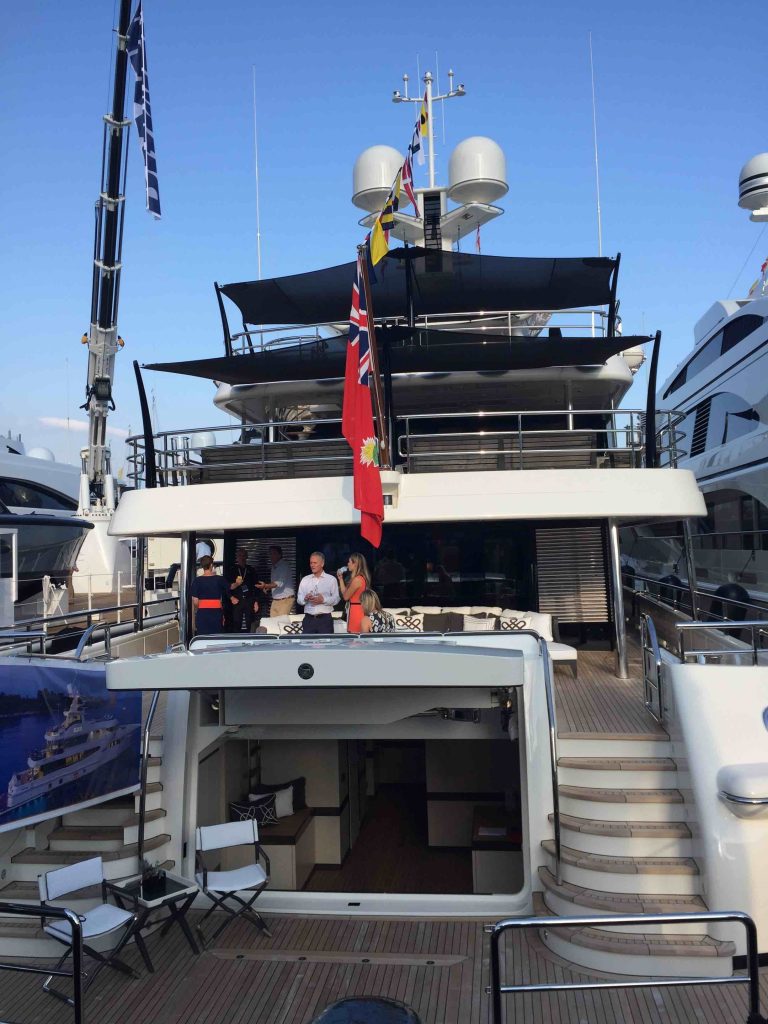
As captain it is you are responsible for the crew, guests and vessel. Every crew member and even visiting guests fall under your command and you have the final say on all yacht decisions. Alongside your qualifications , expect to be paid a high salary in return for your professional service.
Captain/Engineer – A multi-faceted role, this combines the skills of captain with Engineer. A highly sought-after type of crew, they will straddle the skills for both captaining the boat and ensuring engineering issues are dealt with whilst at sea.
1st Officer – Sometimes known as Chief Officer or Chief Mate is second in command to the Captain and manages all the deck crew including the Bosun, Deckhand and any second or third officers. You would be required to undertake bridge duty and thus have a good range of qualifications and skills.
2nd Officer – Is the second-ranking position to the 1st Officer. You would require a good level of qualifications and skills to achieve this position. A 2nd Officer may also be designated in additional areas such as security, medical, or safety, depending on background and specific skills.
3rd Officer – Is the third-ranking position to the 2nd Officer. Qualifications and skills as per the other officer roles are required.
Chase Boat Captain – A chase boat is a vessel which does not live on the main yacht and often has their own crew. These can be towed, driven separately, or berthed in a convenient location.
Chase boats are becoming very popular due to restrictions in tender garage space. As the name would suggest this role refers to the captain who is in charge of the chase boat and subsequent crew.
O.O.W (Officer On Watch) – This is a deck officer in charge of keeping watch on the ships bridge and overseeing navigation whilst on duty. The OOW ensures the ship complies with all COLREGS and safety protocols. This position requires additional qualifications in order to help perform the said duties.
Bosun – Sometimes referred to as the Leading Hand or Senior Deckhand, the Bosun is an experienced deckhand most likely able to take on additional and extra responsibilities. They tend to be the main tender driver and take additional responsibilities in security. Like a deckhand, less qualifications are required, but flexibility and the ability to take direction and blend into the team environment is very important.
Lead Deckhand – As the name suggests, the Lead Deckhand will be in charge of the other deckhands. Generally, only found onboard yachts where more than one deckhand is required, this is a position of responsibility. Ultimately the buck stops with the lead deckhand, so it takes a strong personality and adaptive approach to get the job done regardless of the day or hour!
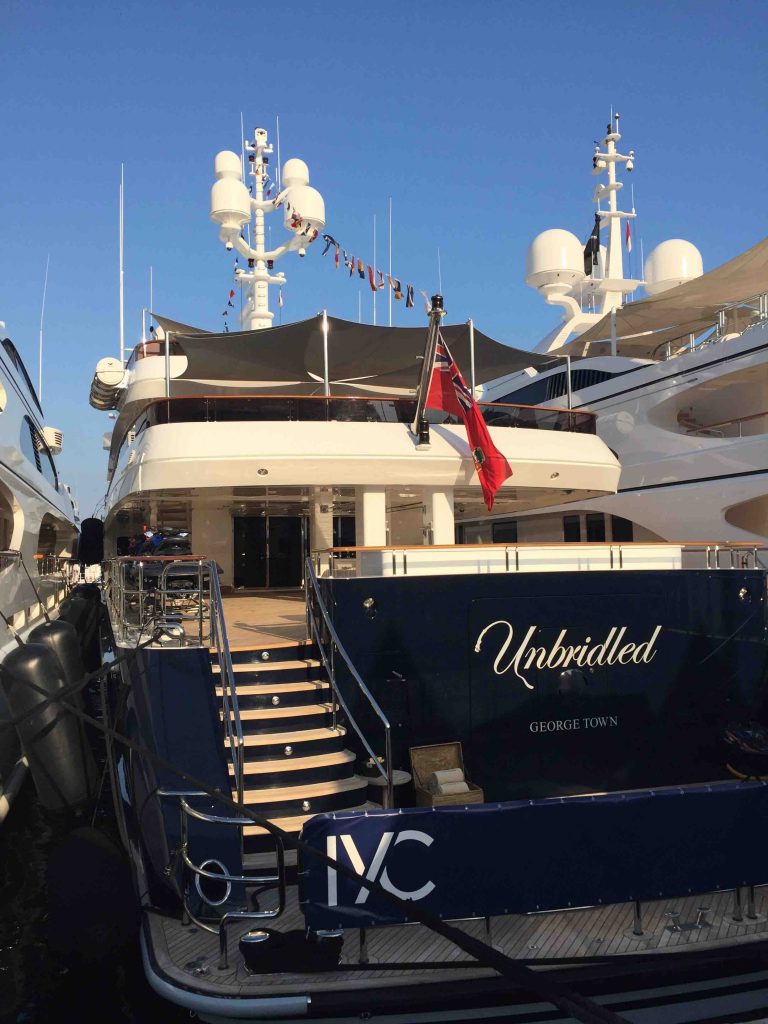
Security Officer – Super yachts are valuable and expensive items, so a dedicated security officer is commonplace. Spending 60 million on a superyacht is considered to be a mid-level purchase in the superyacht world!
Security officers are often employed to take control of all aspects of security, from when the yacht is moored in the bay (and the crew depart for downtime) through to being moored on land. This position is suited to close protection and military background candidates with specific qualifications in security.
Commercial Shipping Master – This is a phrase referring to a Captain of a commercial shipping vessel. They are in essence the captain of the boat (see captain) but will typically be in charge of commercial operations rather than private or chartered yachts and super yachts.
Professional Race Crew – These are unique and exceptional individuals, with a strong background in shipping. Race crew members require a high level of qualification and ability to focus whilst leading the crew and vessel to compete in international competitions.
Purser – Is in charge of the interior and financial matters in accordance to the ship. Normally found on large yachts and superyachts, the Chief Steward will report to the purser. Due to the amount of admin required a strong background of accounts and bookkeeping is required.
Chief Steward/ess – Will be the most experienced member of the Steward team. They will often be in charge of recruiting and training less senior members of the team. The chief steward should have the ability to think ahead, plan for every possibility and focus on the finishing touches and detail required for the very highest standard of service. Yachting qualifications and a proven history of working onboard large yachts are required for this position.
2nd Steward/ess – Second in command to the Chief Steward, the 2nd steward is in charge of all duties as requested by their superior. The 2nd steward ensures interiors, housekeeping, laundry and the presentation of the vessel is spotless. Their duties may include anything from childcare (if required) to pet care. They work closely with the crew to ensure that the guest and clients experience onboard is perfect.
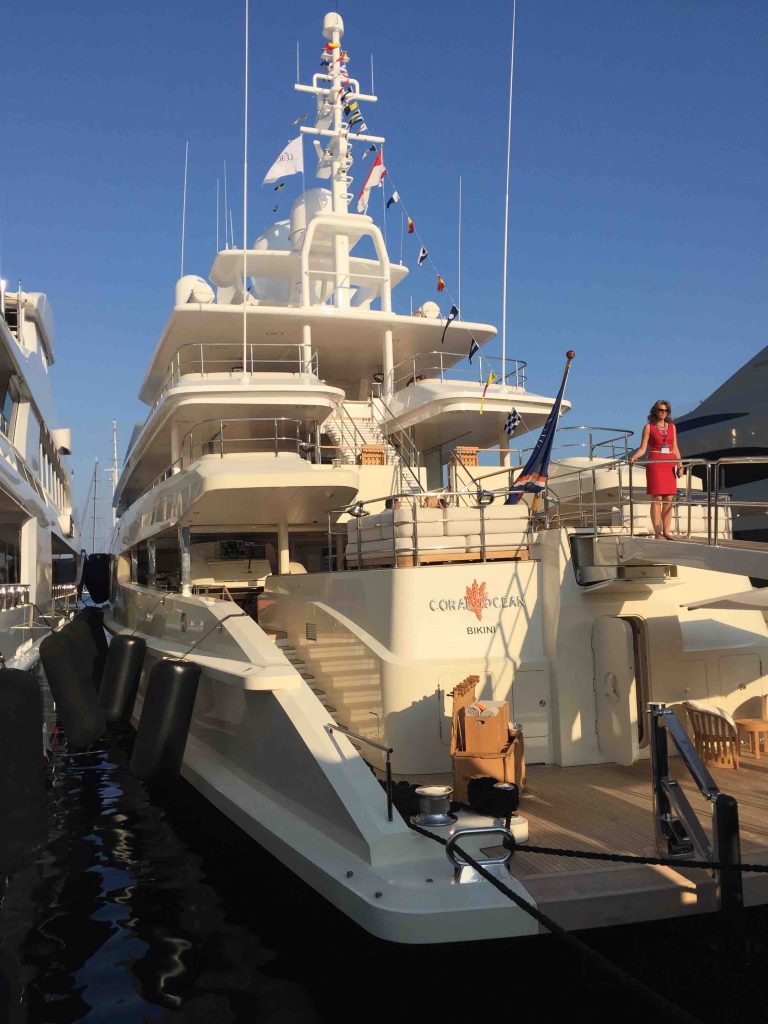
Steward/ess – A role found onboard every yacht or superyacht, the steward is in charge of client experience. From housekeeping through to food and drink service, the steward helps with all aspects of running the yacht. Stewardesses are expected to work long hours and have a good, positive and flexible attitude.
Stew/Deck – This is a combined role between a Steward and Deck crew member. This role straddles both the interior and exterior of the yacht and is a popular choice when needing additional staff on board.
Solo Steward/ess – Typically found on much smaller vessels, the solo steward will be the only steward on board.
Head Chef – Is perhaps one of the most important roles on board. The right chef is the key to a successful crew and perfect guest experience.
A head chef must have a wide range of culinary experiences, and be able to take part in the service for the guests if required, including Silver Service , Buffet Service and Fish filleting at the table.
Sous Chef /2nd Chef – The assistant to the head chef, the sous chef will help the Head Chef with all cooking duties and also cook for the crew of the yacht. Often this role is combined with a steward position, but on the larger vessels this may be a self-contained role (see Cook/Stew).
Cook/Stew – This role combines cooking with steward duties. Assisting the head chef, and then performing standard Steward duties (see Steward).
Cook – This position is suited to an individual who is less experienced as a chef but enjoys cooking. This would be a candidate who is happy to cook for the crew and guests (if required),and will be often used during off duty hours (for example if the chef is sleeping). Generally, not an individual role (unless the yacht is very big), this is a good skill for any of the main crew to have on their CV.
Head of Housekeeping – Often this role is found in the larger vessels or commercial cruises, this person would be in charge of housekeeping and be a specialist in this subject. They would oversee the duties and work closely with the Chief Stew.
Laundry Personnel – This may be a crew member with additional skills in laundry, or on the bigger vessels this may be a dedicated role. This role is typically found more in commercial shipping where the cruise ships require a huge amount of laundry each day at sea.
Beauty/Spa therapist – This is a role-specific with skills in line with beauty and holistic treatments. Superyachts will generally have an area for pampering and your role on the vessel is to satisfy the client’s needs. You would need to have traditional therapist qualifications , along with your yachting qualifications. It is often common to combine the role of 1st Officer/2nd Officer with a combination role.

Masseuse – Involved in the beauty/spa area onboard, the masseuse role is to relax and treat the guests at their leisure. From sports massage through to Swedish and reflexology, a range of massage techniques is preferred. Again, this role can be combined with the Beauty/Spa therapist (depending on the size of the yacht) and can also be combined with main crew duties.
Fitness Trainer – Roles specific for personal trainers or fitness coaches, these team members would work with the guests in the dedicated gym areas helping with fitness goals whilst at sea. These might be specific training programmes or general conditions. Again, this role might be a combined role with other crew duties.
Nurse – An important role, particularly if the yacht doesn’t have facilities for helicopter landing. Qualifications must be in line with medical guidelines, and the nurse or Doctor should have ability to cope with a wide range of illness and ailments. Up to date First Aid and yachting qualifications will also be expected. Again, this role can be combined with the main crew duties.
Engineering
Chief Engineer – This member of the team is required to oversee and ensure that the electrical and engineering of the yacht is operating without issues. They should be flexible and willing to help fix not only important problems, but even be willing to help fix a broken toilet!
At sea the right part might not be immediately accessible, so an engineer should be able to troubleshoot and think outside the box.
2nd Engineer – Second in command to the Engineer, the 2nd engineer assists and helps with all duties around the maintenance of the vessel.
3rd Engineer – Third in command to the Engineer.
ETO (Electrician Technical Officer) – Normally employed on larger vessels where the support is required. They report to the Chief Engineer.
Electrical Engineer – Again this role is similar to the ETO. Reporting to the Chief Engineer and holding qualifications in Electrical maintenance.
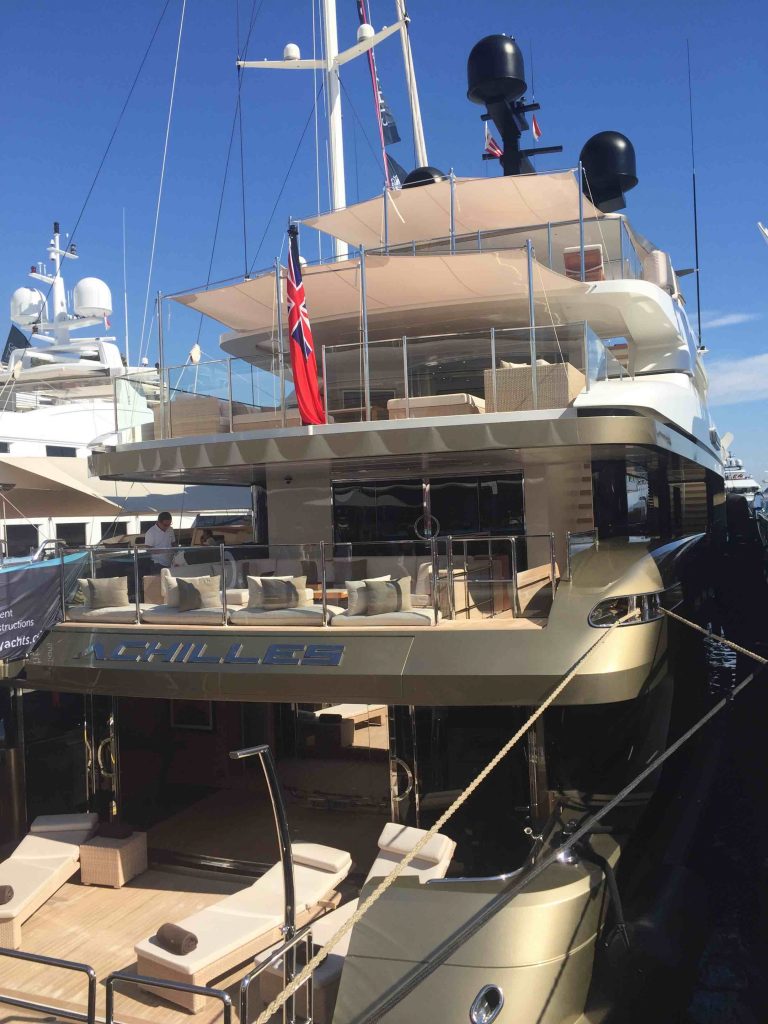
Pilot – For the larger vessels, commercial and cruise yachts, access to the vessel is often by air (helicopter or seaplane). The larger vessels may well have their own aviation permanently stationed on the yacht, and in turn a pilot is required to fly the appropriate aircrafts.
Shore Based
Admin – As the title suggests this team will manage the administration, HR and paperwork of the yacht. Working closely with the purser onboard and with the owner of the vessel, ensuring that the specific operation of the yacht is always managed correctly.
Admin will be closely linked to the Captain, Purser and Chief Steward on the yacht and will involve a whole host of specialised skills from graphic designers through the tech, online support teams.
PA – This role is suited to a highly organised and efficient team member. Working closely with the admin team and the crew onboard the yacht.
Villa Staff – As the name would suggest, this would encompass a wide range of shore-based staff to work within the villa’s typically frequented by the yacht. This could range from a Butler through to Nanny, Housekeeper, Chauffeurs etc.
Contract Workers
Alongside the main crew of the yacht, there are contract workers who are brought in for yacht maintenance. As and when this might be required. These roles are self-explanatory. And they all work to ensure that the yacht is maintained. Any repairs are done efficiently when the yacht is in port or moored for the day.
Roles include: Day Worker, Varnisher, Painter, Spray Painter, Carpenter. Shipwright, Metal Fabricator, Welder, Rigger, Laminator, Electrician. Electrician Expert, Sail Maker, Project Manager. Customer Service Staff and Catering Staff.
How Polo & Tweed Can Help
Did you find this full list of yacht crew & staff helpful? And would you like to work on a yacht? Get in touch with us! Polo & Tweed regularly source and place the finest yacht crew around the world. If you are interested in registering with us or are looking to recruit your new crew members, please don’t hesitate to get in touch with us.
Find Boating Courses
Advertise boating courses.
- Croatia No Longer The Number One Sailing Destination In Europe!
- Why You Should Learn To Sail A Trimaran
- Meteorology Courses – Why Learn This Core Sailing Skill?
- Solo Circumnavigation – How To Master The Art Of Sailing Alone
- How Powerboat Courses Can Improve Your Docking Skills
- December 2016
- November 2016
- October 2016
- September 2016
- August 2016
- February 2016
- January 2016
- December 2015
- November 2015
- October 2015
- September 2015
- August 2015
- February 2015
- January 2015
- December 2014
- November 2014
- October 2014
- September 2014
- August 2014
- February 2014
- January 2014
- December 2013
- November 2013
- October 2013
- September 2013
- August 2013
- February 2013
- January 2013
- December 2012
- November 2012
- October 2012
- September 2012
- boat handling
- Boat maintenance
- Buying A Boat
- Competent Crew
- Competition
- Competitions
- Day Skipper
- Dinghy Sailing
- Disabled Sailing
- Mile Building
- Paralympic Sailing
- Passage Planning
- Powerboat Courses
- Sail Maintenance
- Sailing Courses
- Sailing Experience Courses
- Sailing Regulations
- Sailing Tips
- Sailing Training Courses
- Solo Circumnavigation
- Southampton
- Uncategorized
- Yacht Racing
An Overview Of The Essential Crew Positions On A Boat
Here’s a summary of the main crew roles you’ll find on board a boat.
The Captain
Otherwise known as the Helmsman or Skipper , the captain takes the lead on board and is responsible for guiding the ship and its crew to its destination. A captain should be the most knowledgeable sailor on board, and also exhibit significant qualities of leadership – after all, it’s his direction and leadership that guides the crew in the successful sailing of the ship.
The captain makes many on board decisions himself, and if he needs to consult his crew – perhaps regarding navigation or racing tactics – he’ll have the final say over any decisions made.
The First Mate
The first mate is the captain’s right hand man. His role differs depending on the size of the ship and the number of crew on board. On a small sailing vessel, there may only be the captain and a couple of others – in which case the First Mate’s role will be almost more deckhand-esque than anything else.
On board larger ships, however, the first mate generally has more responsibility. Most of the crew will report directly to him, and he’ll be in charge of the cargo, the safety and the security of the ship.
The engineer performs a vital role on board any powered vessel – it’s his responsibility to make sure all electrical and mechanic equipment is functioning properly. His most important task is to keep the main engines at full operational capacity, but he’s also responsible for repair and maintenance of other equipment such as on board jet skis, remote controls and televisions.
The Bosun is essentially a senior deckhand. He’s tasked with the overall responsibility for the state of the boat, and as you’d expect, is also in charge of the deckhands junior to him.
A ship’s cook plays a crucial role – he’s responsible for keeping guests well-fed and happy, and providing the crew with the right sustenance so they can do their jobs effectively. There are a couple of peripheral skills a ship’s cook needs over and above a chef in a restaurant.
Firstly, he has to carefully select the right ingredients for the voyage – he needs to consider how long they’ll last, and pick “nutrient dense” foods that pack a nutritious punch in small amounts of space.
He also needs to be able to cook in a somewhat unpredictable environment, given the tendency of a ship to buck and sway on the waves. The cook has to take extra care with knives, pots, pans and safety protocols in the ship’s kitchen.
Deckhands are the workhorses of the boat’s crew.
Deckhands have a range of general responsibilities, and their main task is to keep the boat in ship-shape. This includes cleaning, painting, general maintenance and possibly driving tenders or kit such as jet skis for guests.
They may also be required to assist with cleaning, cooking and serving food.
A deckhand is an entry level crew position, and it’s a great place to start if you want to gain experience, work your way up the hierarchy and develop more specialised sailing skills further down the line.
Any of these positions take your fancy? If so, check out one of our Competent Crew course s – they’re the best place to start in order to get your foot in the door for a professional role on board.
And if you like the thought of captaining your own ship, check out the RYA Day Skipper course, which is your fast-track introduction to the role.
Become our Friends!
Get our newsletter.

Yacht Crew Positions and Salaries
The organisational structure onboard a superyacht follows a strong hierarchy based upon a military model. Exact job duties and lines of authority are set and strictly adhered to. This hierarchy is followed on the vast majority of yachts; however, responsibilities of the crew on smaller yachts are often merged.
There are four departments on yachts with clear organisational structure:
- Deck (including Bridge) – Safety, passage delivery, maintenance of the yacht's exterior, guest outdoor activities
- Engineering – Safety and smooth operational running of the yacht
- Interior – Housekeeping, guest wellbeing, activities, accounting
- Galley – Food preparation, stock control, hygiene, galley maintenance
The top of the hierarchy on each yacht is the Captain , who reports to the yacht owner either directly, or through a representative or a yacht management company.
Salaries vary and depend on the yacht size, use, type and location, as well as the experience and qualification of the crew member. We included typical salaries of crew based on the data available from reputable industry sources, as well as our research of over 60,000 crew registered with us.
Deck Positions
The primary duty of the Captain is the overall safe manning and operation of the yacht. Yacht Captain is responsible for the vessel, yacht crew, owner and guests, including personnel management, shipyard/project management, legal and regulatory compliance, accounting, achieving owners' objectives, and answers to the owner regarding all decisions.
| Captain | €4,000 - €15,000 |
First Mate / Chief Officer
The First Mate or Chief Officer is the right hand of the Captain. Takes command of the yacht from Captain when required. Shares Captain's responsibilities as required.
| Chief Officer | €3,000 - €13,500 |
| 2nd Officer | €3,000 - €8,000 |
| 3rd Officer | €2,500 - €6,000 |
| Security Officer | €3,000 - €5,000 |
Bosun / Lead Deckhand
Bosuns are usually experienced Deckhands with additional responsibilities. They are in charge of Deckhands onboard the yacht and often spend a lot of time with guests during outdoor activities. The Bosun is normally the main tender driver.
| Mate | €2,500 - €6,000 |
| Bosun | €2,500 - €5,500 |
| Lead Deckhand | €2,500 - €5,000 |
Responsible for the maintenance of the exterior of the yacht and keeping it in pristine condition at all times. Deckhands also assist in maintaining, cleaning and operating yacht's tenders.
| Junior Deckhand | €2,000 - €3,000 |
| Carpenter | €3,000 - €4,000 |
Engineering Positions
Chief engineer.
Responsible for the Engineering Department and for all technical aspects of the boat and its equipment. The Chief Engineer's duties include overseeing all mechanical and electrical operations, ensuring all planned maintenance takes place and liaising with subcontractors.
| Chief Engineer | €5,000 - €15,000 |
Second / Third Engineer
The Second and Third Engineers report directly to the Chief Engineer. They assist in maintaining all mechanical and electrical operations of the yacht.
| 2nd Engineer | €3,000 - €10,000 |
| 3rd Engineer | €2,500 - €6,500 |
| Sole Engineer | €3,500 - €12,000 |
| Motorman | €2,500 - €4,000 |
ETO / AV/IT Officer
Electro-Technical Officer (ETO) and AV/IT Officer are in charge of daily maintenance of all electronic, computer, audio/visual and communications equipment and their efficient operation. This includes the radio, radar, telephones, satellite communications, navigation systems, computers, Internet connection, interior equipment (TVs, sound systems), etc.
| ETO | €4,000 - €8,000 |
| AV/IT Officer | €4,000 - €7,000 |
Electrician
The Electrician is responsible for maintenance of all electrical circuits onboard the vessel, circuit breakers, switches, lighting, batteries, etc.
| Electrician | €4,000 - €6,500 |
This is an administrative position on large yachts. The Purser is responsible for all operations in the interior department, including inventory, purchasing, provisioning, accounting, organising guest activities, and assisting the Captain with the yachts paperwork.
| Purser | €5,000 - €9,000 |
Chief Steward(ess)
Duties are similar to those of other Steward(ess)es onboard the boat, but on a more senior level, including managing the interior department and training. Small yachts with less crew do not have a Purser. The Chief Steward(ess) is in charge of all the responsibilities normally carried out by the Purser on large yachts.
| Chief Steward(ess) | €4,500 - €8,500 |
| Interior Manager | €4,000 - €8,000 |
| Head of Servicer | €4,000 - €7,000 |
| Head Housekeeper | €3,000 - €5,500 |
| Spa Manager | €3,500 - €5,500 |
Steward(ess)
Steward's or Stewardess's main responsibility is to maintain the interior of the yacht and provide the highest standard of care to the owner and guests. They serve food and drinks, prepare guest activities, pack and unpack luggage and are on call for anything that the guests want anytime day or night. On some yachts, they help the deck crew moor the yacht.
| 2nd Steward(ess) | €3,000 - €6,500 |
| 3rd Steward(ess) | €2,500 - €4,000 |
| Spa Steward(ess) | €3,000 - €4,000 |
| Service Steward(ess) | €2,500 - €5,000 |
| Housekeeping Steward(ess) | €2,500 - €4,000 |
| Laundry Steward(ess) | €2,500 - €4,000 |
| Sole Steward(ess) | €3,000 - €6,000 |
| Junior Steward(ess) | €2,000 - €3,500 |
| Butler | €3,500 - €6,000 |
| Stew/Deck | €2,500 - €4,000 |
The Head/Executive Chef onboard a luxury superyacht is a culinary trained professional responsible for the overall management of the galley department on larger yachts, including guest and crew meals, provisioning, food safety, maintaining strict hygiene standards and financial/budgetary administration.
| Head Chef | €6,000 - €10,000 |
Assists the Head Chef in all aspects of galley duties. The Sous Chef may be required to independently provide crew meals or guest meals at the direction of the Head Chef.
| Sous Chef | €3,500 - €8,000 |
Crew Chef / Cook
Large yachts employ a separate crew and guest chef. The Crew chef provides meals for the crew.
| Crew Chef / Cook | €3,000 - €5,000 |
| Sole Chef | €3,500 - €9,000 |
| Stew / Cook | €2,000 - €4,500 |
Other Positions
Many yachts, especially the large ones, have several additional positions. These are often combined with primary roles, e.g. Stewardess / Masseuse or Deckhand / Dive Instructor . The most common are:
| Beautician | €3,000 - €4,000 |
| Hairdresser | €3,000 - €4,000 |
| Massage Therapist | €2,000 - €4,500 |
| Nurse | €3,000 - €4,500 |
| Dive Instructor | €3,000 - €6,000 |
Career Advice:
Email address:
Remember me Forgotten password?
Password Reset
Enter your email address and we will email you a password reset link.
Email address:
- Yachting for beginners
- Owning a yacht
- Motor Yachts
- Sailing Yacht
- Indian Ocean
- Mediterranean
- Buying or Selling a Yacht
- Yachting Events
- FAQ – Luxury Yacht Charter
- FAQ – Buying a Yacht
- FAQ – Sell your Yacht
- How Much Does It Cost To Charter A Luxury Yacht?
- All our Blog Post & News

Yacht crew positions : Hierarchy, Missions & Salaries explained
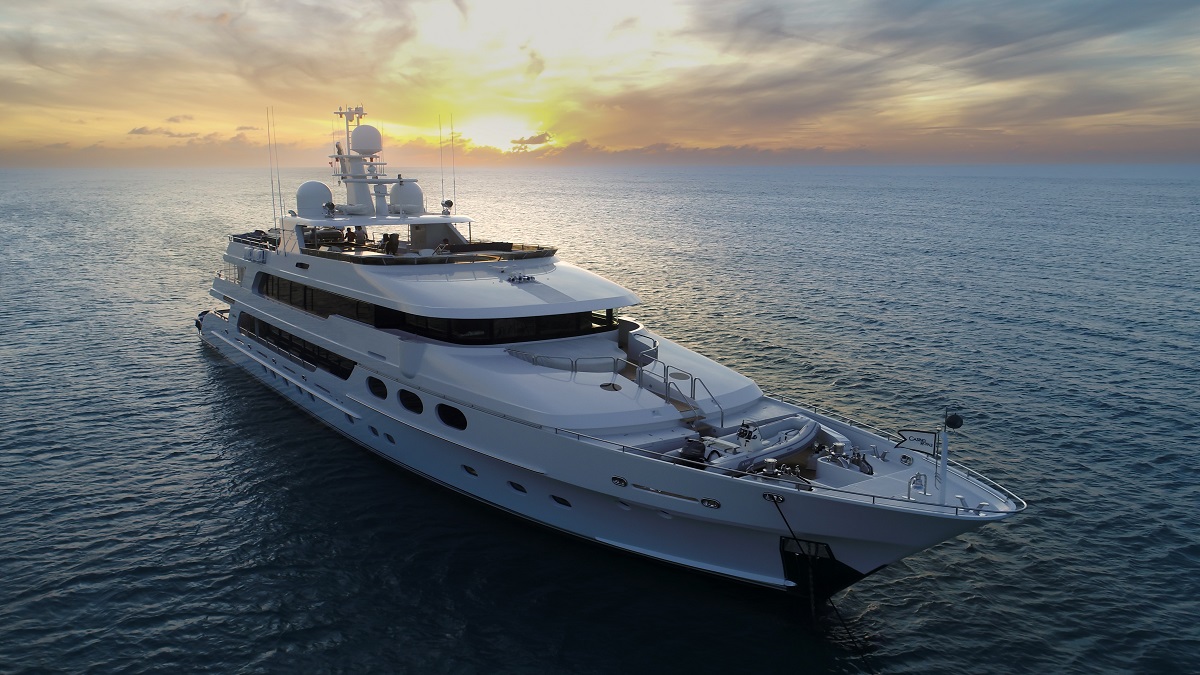
Like any well-run hotel, restaurant, or other luxury service, a crewed yacht needs organized structure and good management. Whether you’re staffing your own luxury vessel or looking for an exciting career working and traveling the world, you need to know how this structure works, and what you can expect to pay or earn and do in the various roles on board.
Every yacht is a little different, and organization may reflect the style of the captain or the demands of the owner. But the same jobs need to be done on almost every boat. Organized with ranks, heads of each division report to the Captain. It’s not a military-style organization, but there are parallels with merchant marine grades and structures.
Smaller yachts need fewer crew, and staff may wear multiple hats that cross more traditional divisions and may combine some jobs with others. Large yachts have more distinct divisions or subdivisions, with more specialization to divide tasks and manage staffing. The core skills are the same, but finding staff with the right blends to do the jobs is key. Crew with broader skills are highly sought after.
As a yacht owner, you shouldn’t have to worry about day-to-day management decisions or organizing all this. That’s why you have a captain, and it’s better to leave staffing decisions entirely up to him or her. But it’s still important to know what it is people you’re hiring do, why they’re there, and how many you need. You don’t want too many crew, or to be short-handed. An understanding of what your yacht needs helps you talk to the captain to keep your yacht running how you want it.
For those looking to break into yacht crew work, consider your skills and strengths, and what jobs appeal to you. You’ll need training before you work, and you can direct your job path through the training you seek. Your goal is a suitable position on a well-run yacht, so make yourself the most attractive candidate possible.
Yacht Work Life
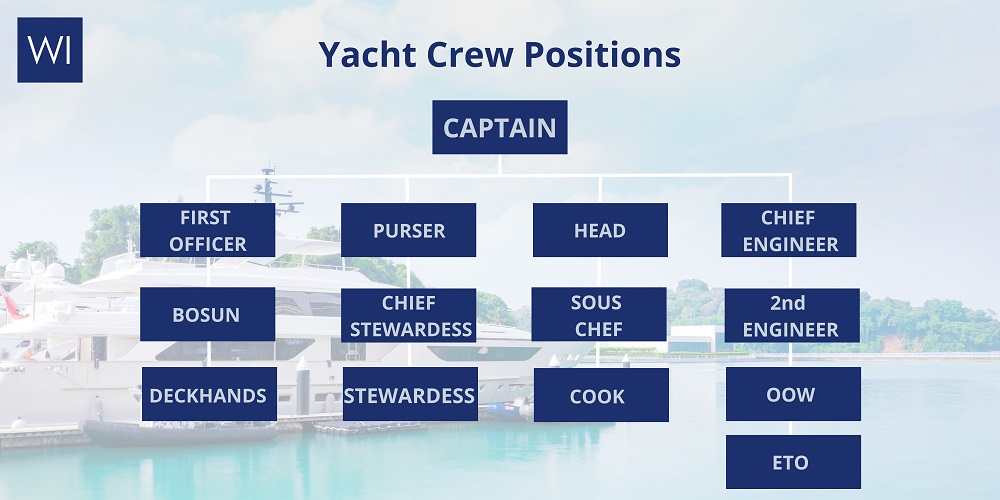
Working on a yacht is also living on the yacht. Crew must have a space to sleep, food, and all the basics that any employee needs. Large yachts have space reserved for crew, and owners looking for quality crew should provide good working and living conditions. Your crew takes care of you, and you should take care of them.
Depending on where a yacht operates or what flag she flies, a variety of labor laws or rules may be in effect. These requirements may be for work visas, contracts and written agreements, and compliance with merchant and ship crew treaties and laws. Be prepared to have work and non-disclosure agreements between yacht and crew, though a few yachts skip this.
Seasonal Jobs
Many yacht positions are seasonal. Year-round employment is more likely for senior crew like the captain and department heads, but not all yachts see year-round use. And some yachts may use different crew in different locales between seasonal moves.
Any job listing should give seasonal information, with geographic information, the length of the season, and the prospects for year-round positions and repeat employment.
Hours, Salaries, and Expectations
Yacht crew is a service job at its core, and every yacht owner is looking for service-oriented people who understand how to deliver a hotel-quality living and restaurant-quality fine dining. Work experience in luxury hotels and restaurants is a big plus for some jobs, and makes breaking into yacht work easier.
Yacht work can be very demanding, with periods of intense work when the owner and guests or a charter party is on board. Long days aren’t uncommon, but often balance with slack time when the boat is empty of passengers. There is always work to be done, but there’s usually a chance for time off.
Most salaries are monthly, since many positions are seasonal. Pay ranges are commensurate with experience, rank, and responsibility. Private vessels usually offer higher base pay, as charter crew can earn tips on top of their base salary. Because of the demands of the lifestyle, compensation is good and you have minimal living expenses on board.
Benefits and Time Off
Because so many jobs are seasonal and may occur in different countries and locations, benefits offered to yacht crew vary widely. But it is not uncommon for crew to be offered health and accident insurance and a flight to the vessel. Living on board, you’ll get food, rooming (usually shared), basic toiletries, uniforms, and laundry. Yachts with a longer view may offer additional training to long-term prospects.
Time off is usually linked to boat use, and may be sporadic in-season or when the boat has the owner and guests on board. There will always be some time off, but it may be between very intense work periods.
Most crew jobs have an employment contract that meets the Maritime Labour Convention 2006 (MLC). This should spell out the contract period and duration, as well as salary, leave and time off, probationary periods, repatriation policies, and any other crucial details to meet the minimum international standards of crew welfare.
This contract should also contain shipboard policies on confidentiality and non-disclosures, drug and alcohol use on board, personal hygiene expectations, interpersonal relationships, and dispute resolution. Job expectations and requirements can also be included, with specific language about roles, tasks, and cooperation between divisions.
Note that all crew agreements will explicitly prohibit drug use on board, most limit alcohol consumption and ban hard liquor on board, and many boats have policies prohibiting intimate personal crew relationships. Because the crew is living on board full time and in close quarters, rules to maintain decorum and crew harmony may be in writing.
Training & Certificates
Two key certifications are required for yacht crew. Employers look for the STCW (Standards of Training, Certification and Watch-keeping for Seafarers) and the ENG1 (Seafarer Medical Certificate). Insurers generally require crew to have these two certifications or the equivalent.
The ENG1 isn’t a class. It’s a medical exam to ensure that the crew is physically fit to serve at sea and has no underlying conditions that may arise far from help. It’s best for prospective crew to secure the ENG1 before investing more time and money training.
STCW is a week-long class on the basics of onboard safety. This includes hands-on modules covering personal survival, fire safety, first aid and CPR, accident prevention, and security awareness. It needs to be refreshed every five years.
Shared, Hybrid, and Crossover Jobs
Larger vessels will have more defined duties and specific areas of responsibility. But smaller yachts may want the crew to have different roles in different situations. For example, a hybrid job description may read “3rd Engineer/Steward” and describe a role in engineering when the boat is empty but on inside crew when passengers are on board.
When hiring or seeking jobs be prepared to look for creative crossover skill sets to meet the needs of the vessel.
Extra Skills and Duties
Any extra skills outside the regular duties makes crew more attractive. From stewards who can teach yoga, give massages or play cocktail piano to deck crew who know how to water ski, SCUBA dive, or fish, anything that crew can bring to enhance the passenger experience adds value to the employee.
If you’re looking for a position, list the skills you’d be comfortable using. If a vessel owner is looking for something specific, spell it out and figure out how that special duty fits into the employee work day.
The Four Main Divisions
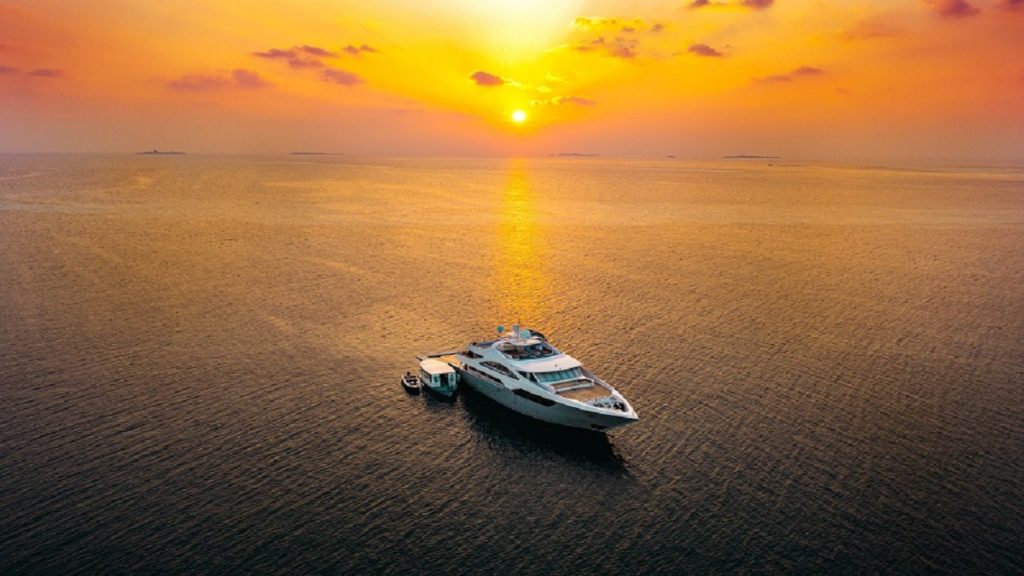
Most yacht crews break into four primary divisions which group related tasks and responsibilities together. While the grouping sounds like it’s by section of the boat, they’re really more functional. For example, stewards (Interior) will definitely serve meals, whether they’re in the main dining room or out on deck. Deckhands (deck) are going to be involved in painting, sanding, and varnish jobs anywhere on the boat.
The deck crew handles most of the exterior operations of the yacht, and runs it. Deck hands and crew keep the boat looking clean and shiny, and handling most vessel operations. This includes driving and operating the yacht, navigation, running all launches and ship’s craft, handling lines, and all maintenance and painting, washing, and shining.
2-Interior (or Inside)
Inside crew are primarily the stewards and housekeepers. Larger vessels will have a dedicated housekeeping staff separate from the stewards, but smaller vessels may not.
Stewards keep the interior clean, do all housekeeping, laundry, food and beverage service, cabin preparation, and anything else needed for the comfort of the passengers.
3-Engineering
Below decks, the engineering department ensures the safe and smooth running of all the ship’s machinery and electronics. Engineers are engine and systems specialists, and there will usually be a dedicated electronics expert. Most engineer jobs require professional training and certification.
Fine dining is a hallmark of the yachting experience, and a full-time galley crew prepares all meals for passengers and crew. The head chef plans the menus and provisions the boat, while junior chefs assist the head chef with meal preparation and keeping the galley spotless.
Yacht Job and Department Details
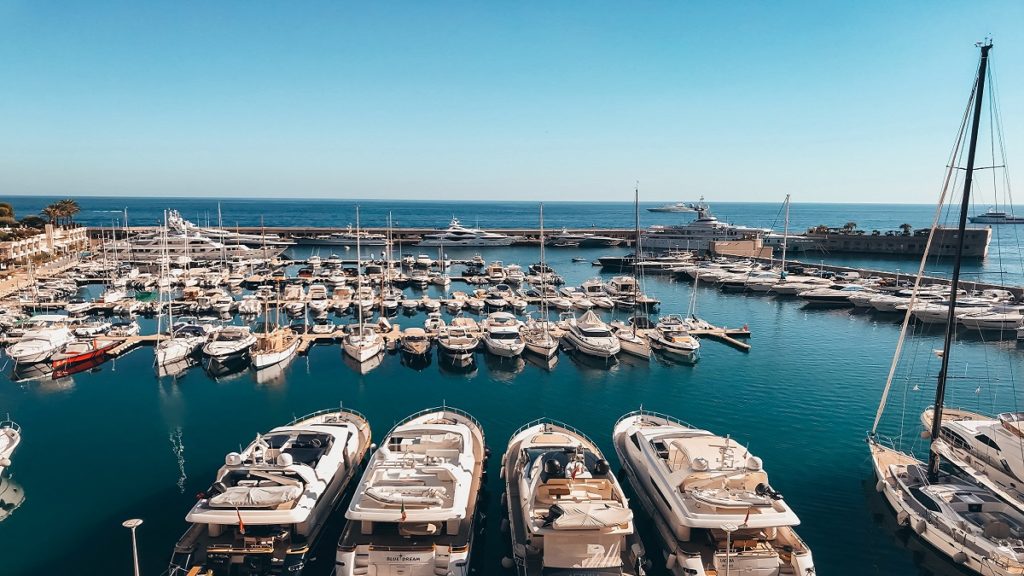
Departments are all organized in a hierarchy, with a department head reporting to the Captain. The clear chain of command makes for smooth operations, with all communications going up and down ranks. Junior staff will occasionally take instructions from other divisions as all crew is expected to help as needed. A captain or department head may organize staff differently, so reporting structures listed are guidelines only.
All salary ranges are monthly figures and are ranges based on yacht size and crew experience. Senior jobs on larger yachts have more responsibility than the same job title on yachts with smaller crews. Experienced crew are very desirable and can expect more pay for their positions.
Listed responsibilities are not exhaustive, and different yachts may allocate some jobs to different positions.
Read also: The yacht charter experience ladder
The Captain

The captain of the vessel is the overall decision maker for the yacht in all situations, including the safety of the vessel. The owner should leave the Captain responsible for operational decisions about hiring and staff and operating the ship. To become a captain requires years of experience and training, and a broad set of skills including yacht operations, personnel management, budgeting and finance. The captain works directly with the owner and owner’s representative, if the captain is not also acting as the representative.
On an organization chart, the Captain is usually placed in the deck division, but the Captain is always the senior-most crew on the yacht and all division heads report to the Captain.
Responsibilities include:
- Responsible for all navigation and running the yacht.
- Senior decision maker on all crew hiring.
- Manage repairs, refits, and yard work.
- Manage budgets and accounting. On larger yachts, this task ends more on the Purser, but the captain is always responsible.
- Ensure all paperwork, clearances, and legal requirements are completed.
- Primary contact with the owner or charter parties.
Reports to: The yacht owner
Salary Range: $6,000 to $22,000
The deckhands handle all the outside responsibilities of the ship, including cleaning and maintenance of the yacht and all the ship’s vessels and toys on board. Deck crew will have significant contact with passengers in this role, operating launches and delivering guests to and from shore and handling the toys.
All deck crew have watch responsibilities on passage, and daily responsibilities keeping the yacht pristine and clean. They will also do line handling and secure the yacht.
Deck department : Chief Mate/First Officer
The Chief Mate or First Officer is the second in command of the vessel, and left in charge when the Captain is not on board. The first mate has the requisite skills to stand in for the captain and run the yacht if needed and usually acts as the division head of the deck team.
The seamanship skills needed are similar to the Captain’s position.
- Primary safety officer for the yacht and all passengers and crew.
- Supervise and manage all operations on deck.
- Bridge watches on passage.
- Passage planning and navigation.
There may be additional mates on larger vessels, these 2nd, 3rd, etc. mates have similar responsibilities on rotation. But the first mate is senior and always second in command.
Reports to: Captain
Salary Range: $4,000 to $9,500 (First mate)
Second and more junior mates may earn $2,000 to $4,000
Deck department : Bosun
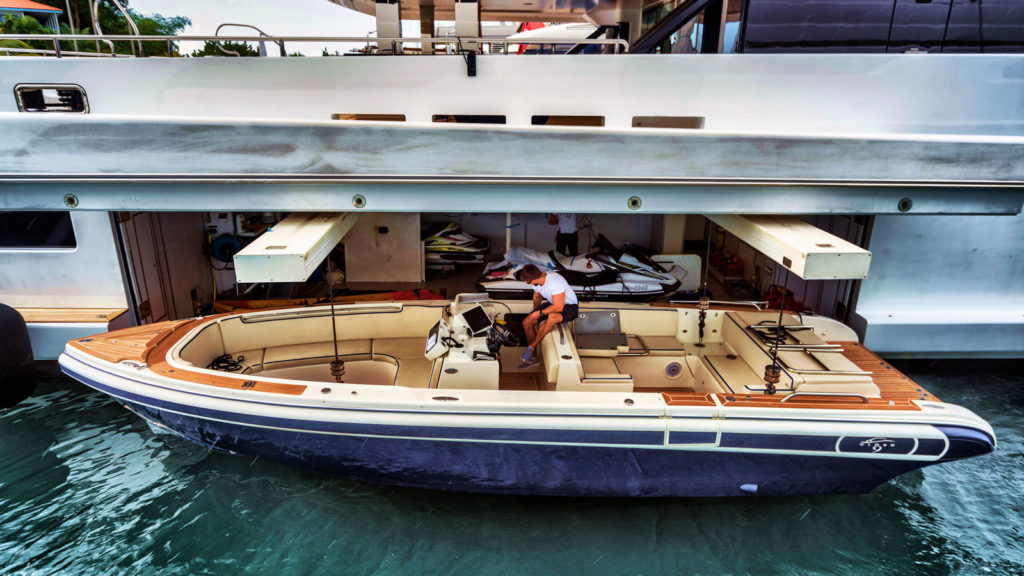
The Bosun is the senior deckhand and manages the junior hands on board. This will usually be the most experienced hand on board.
- Organizing all operations on deck.
- Coordinating the use, storing and launching of the ship’s boats, toys, and equipment.
- Managing the passerelle, watching passenger safety.
- Contact point for guest service on boats, toys, and trips to shore.
Reports to: First mate
Salary Range: $3,000 to $5,000
Deck department : Deckhands
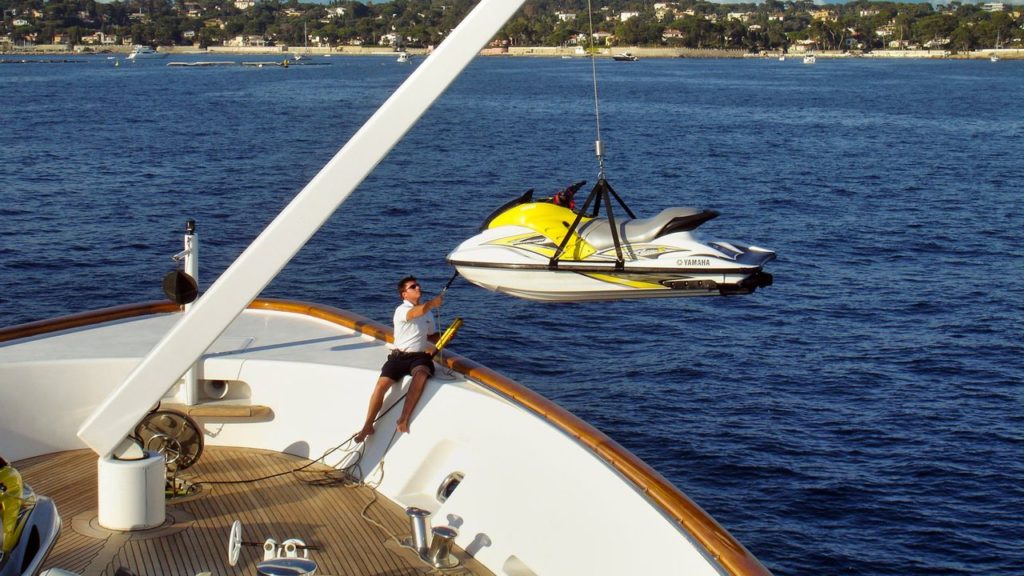
Deckhands are constantly busy with maintenance, cleaning, polishing, and assisting guests as needed. They will assist other departments as needed or given special duties.
- Daily cleaning of the yacht’s exterior.
- Painting, varnishing, polishing.
- Line handling.
- Launching and operating dinghies and tenders.
- Repairs and carpentry.
- Helping guests as needed – everything from handling baggage and gear to embarking and disembarking.
Reports to: Bosun
Salary range: $1,300 to $3,000
Though every position on a yacht is service-oriented, the interior or inside crew provides the primary customer service. They will interact the most with the passengers daily, and they’re directly responsible for the quality of their experience on board.
Interior department : the Purser
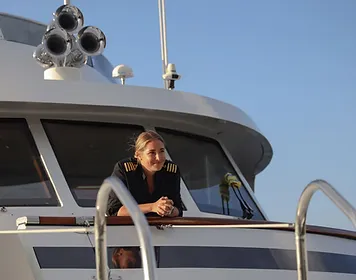
The purser is the chief financial officer of the yacht and handles all the financial operations on board. Accounting, purchasing, payroll and hiring, and all money matters end up with the Purser. This is a senior staff position, and may be the interior department head. Smaller yachts may eliminate the purser’s job and add it to the captain’s and other senior staff duties.
Responsibilities Include:
- Accounting and bookkeeping for all financial transactions.
- Human resources and payroll.
- Handling logistics for all departments related to purchasing.
- Managing contracts.
- Event coordination, including off yacht bookings and payments.
- Primary administration of the boat’s business paperwork.
- Inventory and supply management.
Salary Range: $4,000 to $8,000
Interior department : The Chief Steward/ess

The chief steward or stewardess has primary responsibility for all service roles inside. Food and drink service, cabin preparation, and anything to do with helping the passengers be more comfortable and enjoy their stay. The chief steward will be inside crew with several years of experience.
The chief steward manages the interior staff, setting and enforcing vessel service standards. The chief steward ensures the crew delivers a five-star hospitality experience.
Chief Steward Responsibilities:
- Scheduling and training junior crew for meal and drink service and cabin preparation.
- Primary contact with guests for meals and drinks.
- Sommelier and wine service.
- Coordinate with the galley for meals and presentation.
- Decorate the interior, from flower arrangement to table settings.
- Arrange onshore activities and outings.
Reports to: Captain or Purser, depending on the yacht
Salary Range: $4,000 to $8,500
Stewards/Stewardesses
The stewards and stewardesses are the primary guest service staff. They will work closely with guests and passengers, and have daily contact with them as they meet most of their needs while on board.
Steward Responsibilities:
- Food and drink service.
- Room preparation and turndown service.
- Cleaning, polishing, housekeeping, and inside maintenance.
- Cabin detailing.
- Laundry, pressing, and folding.
- Help with outings, trips, debarkations.
Reports to: Chief Steward
Salary Range: $1,500 to $4,500
Housekeeping

Larger yachts may have a dedicated housekeeping and laundry staff. This will be part of the inside crew, under either the purser or the head steward. There may be a senior housekeeper, if there are more than one housekeeping crew on board.
Responsibilities are the cleaning and laundry portions of the steward’s job, and a laundry steward may spend most of her time inside the ship’s laundry.
An experienced Head of Housekeeping may earn from $4,500 to $7,000, while a Laundry Steward typically earns from $2,500 to $3,500.
Read also: CAN OWNING A YACHT TO CHARTER (REALLY) BE PROFITABLE?
Food service requirements on any yacht are high. Whether it’s a privately owned vessel or a charter, the expectations are always for top tier food service, with a variety of meals planned for the requirements of every passenger. Chefs and cooks prepare all meals on board for passengers and crew, but sometimes other interior crew may help with prep work or cleanup.
Smaller yachts have smaller galley crews, but the largest vessels may have an executive chef and several sous chefs. All chef positions require formal culinary training and experience, but cook positions are often entry level. Promotion from cook to chef is unusual without additional training.
Galley department : the Head / Executive Chef

On larger yachts, an Executive Chef will run the entire galley with the help of sous chefs and cooks. With an Executive Chef, there’s an expectation that the food and menus will be on a level with Michelin star-rated restaurants.
The executive chef brings a thorough understanding of food preparation and presentation, and moves food preparation past creative up to artistic. Job responsibilities are similar to a chef, but the job demands and the required experience and education are much higher.
Salary range: $7,000 to $11,000
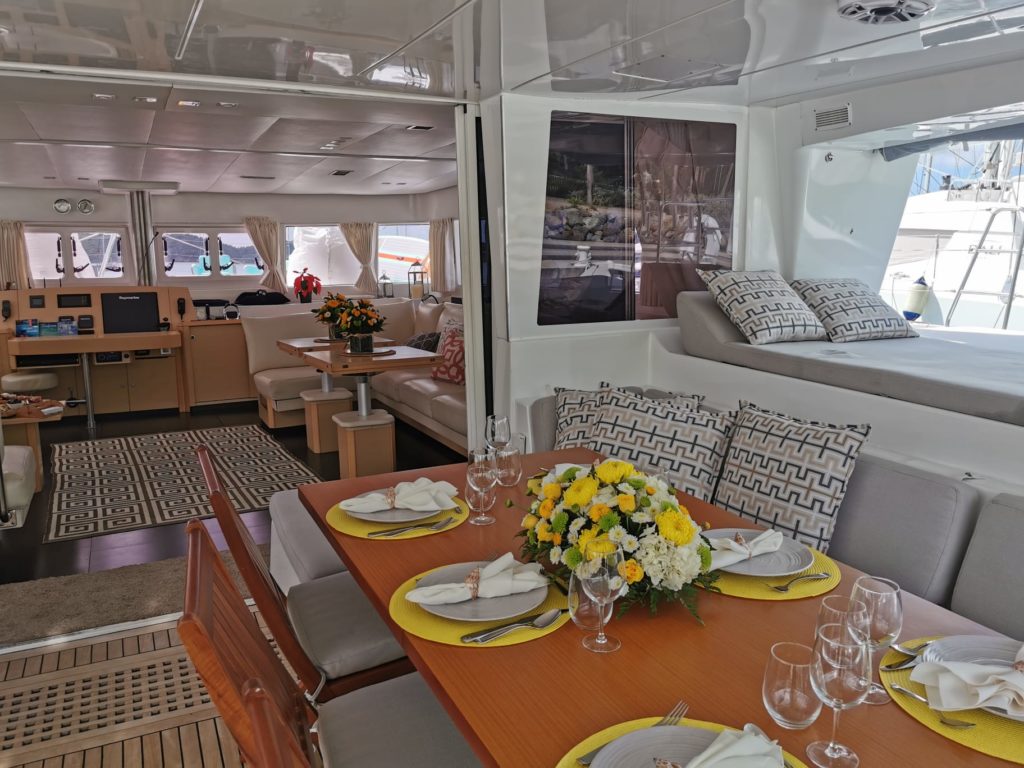
The chef has overall responsibility for all meals on the yacht, from provisioning in remote places to hygiene and good safety. If there’s only one chef, she’s the head of the galley crew. Finding the best provisions in far away locations and making the best of local food availability is a major part of the job.
- Planning a delicious and varied menu for passengers.
- Sourcing all food and arranging transport to the yacht.
- Maintaining and operating within the galley budget.
- Preparing passenger meals with professional presentation and style.
- Cleaning and maintaining galley and galley equipment.
- Deliver menus and meals on time, while running an organized and spotless galley.
Galley department : Sous Chef
The sous chefs assist the chef in all aspects of running the galley, and may have independent assignments to plan and guest and crew meals. While not primarily responsible for provisioning, the sous chef will help with food selection, menu preparation, and planning. A sous chef must have formal culinary training.
Reports to: Head chef
Salary Range: $3,500 – $6,000.

Galley department : The Cook
Cooks may be entry-level positions or experienced, but do not require formal gastronomy education. They will assist the chef and sous chefs, cooking meals and dishes for guests and crew, helping with provisioning, and keeping the galley neat.
- Assist with provisioning and buying high-quality food from local sources.
- Follow all food handling and safety guidelines.
- Assist the head chef as needed, taking direction and guidance.
- Prepare guest and crew meals as required.
- Staying on top of galley inventories and supplies.
Salary Range: $2,500 to $3,500
Engineering
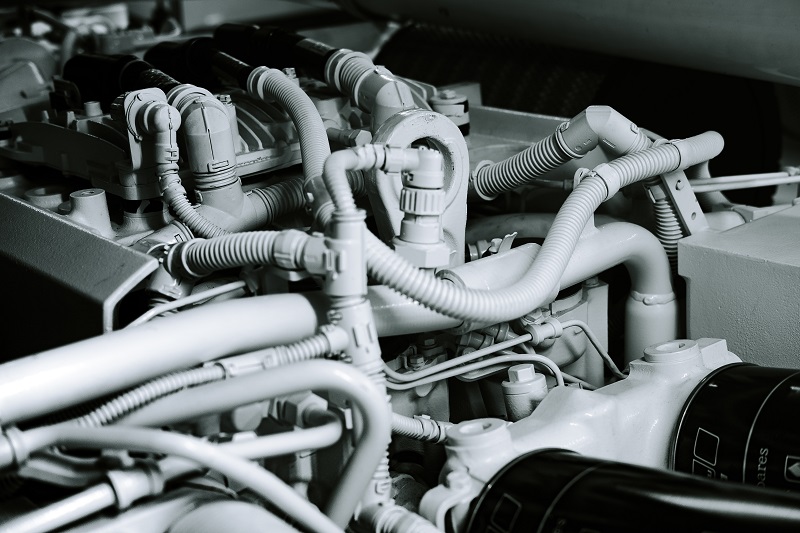
The engineering department keeps the yacht and all its systems working. Whether it’s the engines, electronics, air conditioning, or the plumbing – it’s up to engineering to keep it running.
There is considerable overlap with commercial shipping in the engineering field, as many of the same skills apply. And there is a broader range of qualifications and grades based on the size and power of the vessel. Job ratings may be set by required experience based on tonnage of ship or power of engines, with corresponding levels of pay and responsibility.
Unlike commercial shipping, engineers may get involved in other aspects of running the yacht, like helping with docking and water sports with mechanical toys.
Engineering certifications, training, ratings, experience and licensing are critical to hiring competent engineers, and for engineering crew it’s an important facet of career advancement. This is important for Chief and 2nd Engineers, which are often broken out by MCA (U.K. Maritime and Coastguard Agency) rating or other international equivalent.
MCA ratings for engineers Commercial and Private Yachts over 24m are:
Y4: Less than 200 Gross Tons and less than 1,500 kW engine power Y3: Less than 500 GT and 3,000 kW Y2: Less than 3,000 GT and 3,000 kW Y1: Less than 3,000 GT and 9,000 kW
There is also an unlimited rating for merchant vessels larger than the Y1 category. For discussing salary and responsibilities, we will include all ratings in one position description, but pay scales with the size of the yacht and any required higher ratings.
Chief Engineer
The chief engineer manages all aspects of keeping the yacht and its systems running. The chief engineer manages all the engineering staff, and directs all maintenance, repairs, troubleshooting and upgrades. This is a management position, but requires extensive hands-on technical experience and knowledge. Chief engineers on large yachts hold an MCA Y1 or Y2, smaller boats will have a lower rated chief and a smaller staff. Check Jooble.org to find abroad marine engineer vacancies.
- Provisioning, shopping, and stocking.
- Preparing passenger and crew meals.
- Following instructions and cooking under the direction of others.
- Galley cleaning.
- Follow food safety and storage procedures.
- Food pre-preparation.
Salary Range: $6,000 to $15,000
2nd Engineer
The second engineer is also a highly skilled position requiring a rating or license and several years of experience. This senior level engineer also needs knowledge of how to troubleshoot and maintain all yacht systems.
- Maintain and manage all engineering operations.
- Hire, train and supervise all engineers.
- Project manage all upgrades and retrofits, including managing budgets, contracts, and suppliers.
- Coordinate maintenance schedule for the entire yacht around the usage and seasonal schedules.
- Maintain costs and accounting for engineering operations.
- Design and handle all safety operations.
- Set and maintain standards for operations and cleanliness in the engine room.
Reports to: Chief engineer
Salary Range: $5,500 – $10,000
OOW (Officer of the Watch) Engineer
The OOW is a junior engineering position, but still licensed. There are two categories of OOW – MEOL (Marine Engine Operator License) and the more junior AEC (Assistant Engine Course). The overall responsibilities are similar, working to support the senior engineers and handle independent assignments. The AEC rating is entry level for licensed crew, but has training and certification.
- Support the chief in all projects.
- Maintain a clean, safe engine room.
- Perform all maintenance, troubleshooting and repair tasks as needed.
- Support motorized water sports.
- Occasionally assist with other vessel operations, like line handling.
Reports to: Chief Engineer
Salary Range, MEOL: $4,500 to $6,000 Salary Range, AEC: $2,500 to $3,500
Electronics/Technology Officer (ETO)
The ETO takes responsibility for all audio-visual and information technology on board. Ensuring passengers have access to the internet, movies, television, and music is a primary responsibility. This position carries a fair amount of passenger interaction, and an ETO needs good troubleshooting skills to go with customer service skills.
- Ensure all audio/visual and entertainment systems are always available for passengers.
- Assist passengers with personal technology and ship systems as needed.
- Conduct regular maintenance and upgrades of the network, information, and A/V systems around passenger schedules.
- Assist other engineers as needed, especially with electronic systems.
- Contribute as needed with other departments for boat and passenger operations.
Salary Range: $4,000 to $9,000
Junior Engineer
This is a lower or entry level position for someone with engineering skills but without formal licensing or certification. The junior engineer will help with safety and cleanliness, and assist in any engineering tasks as needed. The ability to solve problems and fix things opens this spot for anyone capable and willing to do the job.
- Help with cleaning, maintenance, and safety functions.
- Help anywhere needed on the yacht.
- Assist senior engineers as needed, taking direction and following instructions exactly.
- Constantly develop skills.
Read also: IS BUYING A BOAT A BAD IDEA?
Whether you are a yacht owner or considering entering this dynamic industry with an established and reliable crew, it is essential to have an understanding of the yacht’s hierarchical structure, mission priorities, and salary expectations. By doing your research on the complexity of yachting before hiring your team, you can confidently select the right group of experienced and qualified professionals for your needs. Staying up-to-date on top industry trends and knowing the capabilities of each type of yacht crew position will enable you to make sound decisions that support a safe and cost-effective journey. With quality personnel at your helm, you can cruise unhindered in luxury and explore new destinations with peace of mind.
Fractional Yacht Ownership : Everything you Need to Know
What is the best country to register your yacht offshore, you might also like.

What differentiates a yacht from a superyacht or a mega yacht?
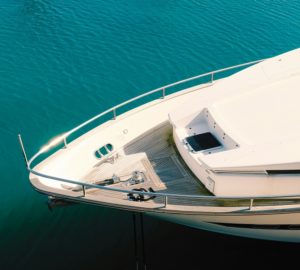
Chartering Requirements and Regulations: A Guide for Boat Owners

What are the Fastest Cruising Catamaran on the Market?

- Career Advice
- Salary Guide
- Dockwalk Presents
- Digital Dockwalk

What are the Different Crew Roles on a Luxury Yacht?

Holly is the editor of Dockwalk. She grew up racing sailboats in England before switching to the world of superyachts and moving across the pond to Fort Lauderdale.
So you’ve scored your first job as crew on a superyacht — great! Here is a who’s who of everyone you will meet on board...
The role : Responsible for the entire vessel, including crew and guests
Responsibilities : Navigation, safety, personnel management, regulatory compliance, budget management
Reports to : The owner
The captain is the highest ranking member on board and carries four stripes on his/her epaulets . Not only is the captain responsible for the vessel’s safe navigation and operation, but every soul on board falls under their command, even the guests. Much like a ”sea-based CEO,” the captain oversees the entire operation from the exterior to the interior. They spend a significant amount of time in the wheelhouse navigating, but the role also requires a great deal of financial management, hiring, appraising, and dismissal of crew. Captains have an extensive amount of maritime experience, training, and seafaring knowledge, as well as a solid grasp of administration duties and accounting. On smaller vessels, the captain might be required to be more hands-on, but on larger vessels, s/he will be assisted by a number of supporting roles, such as the first officer.
First Officer
The role : The captain’s second in command
Responsibilities : Navigation, overseeing docking procedures, managing deck crew, maintenance of deck equipment, watchkeeping
Reports to : Captain
The first officer, also known as the chief officer or first mate, is the second in command and serves as the right-hand man to the captain. Their roles are similar with some duties shared but this can vary from vessel to vessel. The first officer will have a thorough understanding of the bridge and navigation systems and should be able to step in the captain’s absence. They will oversee all deck operations and maintenance and manage the deck crew as well as a long list of administrative duties. The first officer will also have knowledge of all safety procedures on board in case of an emergency.
Second Officer
The role : Supports the first officer and captain
Responsibilities : Managing deck crew, maintenance of deck equipment, navigation, watchkeeping
Reports to : Captain/First Officer
Most yachts will have a first officer but larger yachts might employ a second or even a third officer. This role is often filled by a former senior deckhand who is working their way up the ladder to become a captain. Essentially, the second officer acts as an understudy to the first officer and is jointly responsible for navigation, bridge watches, and management of the deck team. The second officer may also be the designated security, safety, or medical officer on board.
Chief Stewardess
The role : Responsible for the interior of a vessel
Responsibilities : Managing the interior team, food and beverage service, cabin preparation, liaising with guests, interior detailing, training of interior crew, upkeep of inventories and provisioning, orchestrating guest activities
The chief stewardess is the head of the interior team and often the first point of contact for guests during their stay on board. Reporting to the captain, the role involves the maintenance and presentation of the interior as well as the training and management of a team of stewardesses. Chief stewardesses have an expert eye for detail and are able to deliver a seven-star luxury experience by going the extra mile for guests and keeping an impeccable interior. They must be able to anticipate the needs of guests on board as well as being able to delegate duties to their fellow stewardesses. A chief stewardess is a superb organizer and is often tasked with arranging guest activities ashore, planning themed evenings, and throwing parties.
Second/Third Stewardess
The role : Responsible for maintaining the interior
Responsibilities : Housekeeping, interior detailing, food and beverage service, flower arranging, party planning
Reports to : Chief stewardess
The second and third stewardesses report to the chief stewardess and are responsible for the execution of all interior duties from guest service to bartending, cabin detailing, and laundry. This is a role that requires a high degree of organization , attention to detail, and discretion.
The role : Responsible for overseeing accounting and managing operations and administrative work
Responsibilities : Overseeing the accounting and budget, crew HR, port clearance, guest concierge
The purser is both an administrative and managerial role and more commonly found on larger vessels. Often filled by an experienced chief stewardess, the role of a purser is to manage the accounting and operational budget, customs for the vessel and goods, immigration for crew and guests, and handle trave logistics and itinerary management. They are also in charge of crew HR, including payroll, leave, crew travel, certificate management, and contracts. They can assist with procurement and will ensure all items are shipped to the vessel and delivered on board. The purser is the first line of contact for shoreside suppliers, agents, and management.
Chief Engineer
The role : Responsible for the engineering department and technical equipment
Responsibilities : Overseeing the vessel’s mechanical and electrical systems, managing and supervising repairs, managing and training a team of engineers
Day to day, the chief engineer is responsible for the maintenance of all the mechanical and electrical operations. As such, the chief engineer will have detailed knowledge of all systems on board the vessel, from engines and generators to air conditioning, refrigeration, electronics, and hydraulics. Troubleshooting is an essential skill for any engineer working on board a yacht and the chief engineer will manage or supervise any repair work required. Where repair work requires an external operative, the chief engineer will be responsible for coordinating with shore-side engineers. He or she will also be required to manage and train an entire team, which on larger vessels might consist of engineers, electricians, and ETOs (Electronic Technical Officer).
Second/Third Engineer
The role: Support the chief engineer in the maintenance of all onboard systems
Responsibilities : Maintaining the vessel’s mechanical and electrical systems, repair work
Reports to : Chief engineer
As the size of a yacht increases, so does the number and the complexity of systems on board. A second or third engineer might be required to pick up some of the maintenance work required.
The role : To maintain the exterior of a vessel and manage the deck crew
Responsibilities : Managing the deck crew, overseeing, assisting with and executing maintenance work on deck, line handling
Reports to : First Officer
The bosun is often an experienced former deckhand and leads a team of exterior crew. He or she is responsible for the maintenance of the exterior, from cleaning windows and daily washdowns to painting, caulking, and other basic repairs. As one of the more experienced members of the deck crew, they play an important role in communicating with the captain and first officer during docking procedures and are usually the first to get behind the wheel of a tender. The bosun will have a working knowledge of the toys on board and will supervise guests.
The role : To maintain the exterior of a vessel and assist with deck operations
Responsibilities : Wash downs, polishing, assisting the bosun in maintenance projects, supervising toy use, line handling, tender driving
Reports to: Bosun
Naturally, the bigger the boat, the larger the number of deck crew you have, which might consist of a lead deckhand and junior deckhands. The deckhand will support the bosun in executing maintenance and repair projects on deck and will assist in keeping the exterior of the yacht in immaculate condition. You can spot a member of the deck crew gripping a brightly colored chamois in one hand.
The role : Responsible for food on board
Responsibilities : Provisioning, menu planning, preparing meals, budget management
The chef plays an all-important role on board and is responsible for preparing and delivering meals to the highest possible standard. The superyacht chef will typically have experience working in restaurants or hotels or as a private household chef, with detailed knowledge of local and seasonable produce, food and wine pairings, and the ability to prepare menus with limited availability. A yacht chef will have often had extensive training with the ability to execute meals with precision and creative presentation and be able to adapt to any dietary requirement with ease. On smaller yachts, the role might be absorbed by a stewardess, while larger yachts may employ a sous chef.
Sous Chef/Crew Chef
The role : Supports the chef in provisioning and preparing meals
Responsibilities : Provisioning, menu planning, preparing meals
Reports to : Chef
Bigger yachts might have a sous chef to assist in the execution of breakfast, lunch, and dinner, for guests and crew. They will have similar knowledge of produce and menu planning with the ability to execute meals with detail. Some yachts will even have a dedicated crew chef who cooks for the crew only.
*Roles and responsibilities may vary from vessel to vessel
More advice for new crew
- Advice for Crew Getting Started in Yachting
- The Top Yacht Crew Jobs This Week
- 101 Words You Need to Know as Crew
More from Dockwalk
Most popular on dockwalk.
What Each Crew Position Wants You to Know
August 2, 2017
This article is a guide to show how small improvements can make a big difference for your fellow crew. Read on to learn what your crew wants you to remember each race!
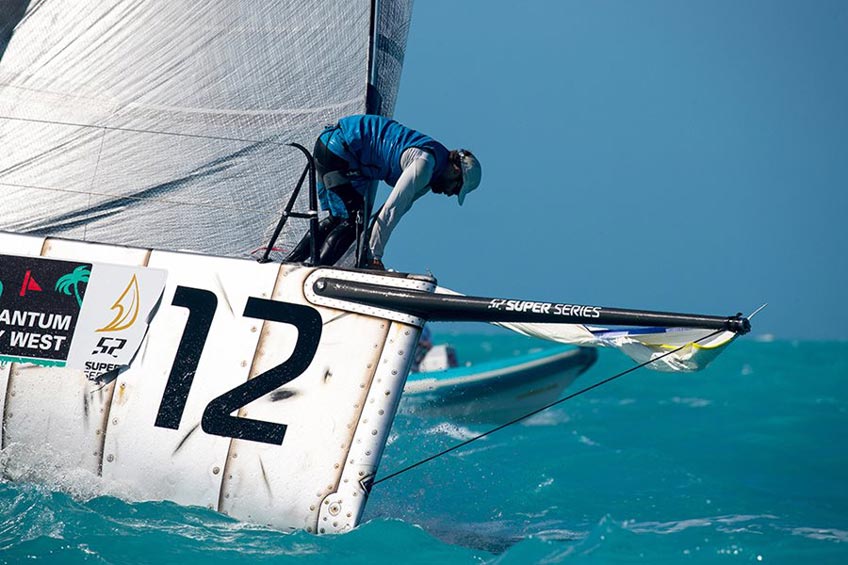
While it’s important to master your position on the boat, it’s equally as important to understand what’s going on in other domains and what you can do to make your teammates’ life easier and help the boat sail smoothly.
We reached out to a mix of successful sailors to find out what they want the other crew members to keep in mind to help them execute their job the best they can. Here’s what they had to say.
“The race is not over until the spinnaker comes down. It is easy to switch to recovery mode right after crossing the finish line, but this can be costly with a messy takedown, ripped or wet sail. To go along with this, after races finish send the jib bag up before the food bag! It’s frustrating for the bow when I’m are ready to flake the jib and everybody is eating.
I am happy to see the tactician’s general awareness of the bow team. We understand tacking mid jib-flake can’t always be avoided, but a quick cleanup with everyone cooperating makes life much easier. Lastly, my lifeline is the pit position, I like when this person is attentive and stays by their position until the bow team finishes cleaning up between races!” Anonymous bowman
“The mast is a lot easier when trimmers have patience on the set. They can pop the spinnaker open by sheeting too early and make the mast and foredeck look terrible! My key teammates are sewer and pit: a spinnaker set never works well if the trimmers, mast, sewer and pit are working independently, but when we hit on all cylinders, the set will be a thing of beauty. The other critical players to a happy mast are the tactician and helmsman. If the boat isn't in proper orientation to the wind when it is time to take the spinnaker down disaster can strike. A great bow/mast team will make it work, but a little waggle to help collapse the spinnaker goes a long way for a clean drop.” Andrew Spaulding*
“Be mindful of where things are thrown. For example: a jib change on the run, I may not be the one putting the old jib or bag down below, so I ask teammates to be mindful of the flaked kite halyard. I flake it once and then spend the rest of my run focusing on weight placement, pole position, finding the leeward marks and it becomes time consuming to have my head in the boat for longer than necessary.
The pit is in the middle of two groups. When it comes to maneuvers, the bow and brain trust may not always be on the same page, and I often have to decide which one to follow. If the back of the boat is calling for something that the bow is not ready to do; I can't force the issue. I can facilitate it, convey the sense of urgency, but I can't take the spinnaker down or jibe it by myself. This communication becomes easier if I receive clear and timely information from either end of the boat.” Scott Murin
Headsail Trimmer:
“Acknowledgment of communication. If I ask a teammate to do something, they should either act on it immediately or answer ‘copy’. If there is no acknowledgment, the person making the request often asks two or three times getting louder each time. I often see this situation and, my ultimate pet peeve is when the teammate finally answers and says ‘I HEARD YOU!’ When people say “copy” I can leave the task with them and move on. My other suggestion is to make habit of saying the person’s name before making a request so their attention is grabbed and time is not wasted by repeating what they didn’t hear before their name was called (this could be the difference between a collision and a race win).” Morgan Trubovich
“A briefing with the days goals. There should be a morning discussion describing the weather, potential courses, and anything else important. After the team is on the same page, people can break into groups depending on who they need to interact with throughout the day. I talk to my offside trimmer and grinders about what situations may come up and then I talk to the main trimmer about possible sails and boat settings.
It is also important to have quiet and calm maneuvers. I like to have ongoing discussions about what’s to come so when the boat is actually turning everyone has already anticipated their weight placement and I can focus on feeling the sheet run through my hands.” Dave Gerber
Main Trimmer:
“The most important thing is pressure calls and relatives. A main trimmer is ‘head in the boat’ which only gives them so much feel, so consistent and accurate information are crucial for boat speed. I am happy with simple dialogue with the tactician to know what modes are expected. If we develop standard steps, it becomes easy to be on same page.
The jib and main must also cooperate, they are constantly working together to make the boat do what the tactician wants. As a main trimmer, I let the jib do what they want and communicate when they are hitting the main or when they can be tighter. It’s good to develop concise key words and terminologies for any maneuver where the main has to be fine-tuned; some examples: high build, high kill, half tack, speed build, or racing.” Luke Lawrence
“I love it when new crew get onboard, listen to the race conversation and offer input where it might be lacking or where he/she can contribute value. For example, if no one is calling breeze on the rail, it’s great to have a crew take the initiative to make very concise and valuable breeze calls (Puff on in 3, 2, 1….). It’s also great when new crew take a few minutes to observe, listen and see what info or help might be needed instead of diving right in without first watching or thinking. It's valuable when a crew member offers input and "finishes the sentence." How many times have you heard someone say "...the right has a lot of pressure...." AND what??? Inquiring minds want to know. Finish the sentence: "... and they look strong/are headed/etc." Completing the sentence and picture for the tactician, driver and speed team is extremely helpful. A positive attitude and imploring the “5 second rule” (does what I’m about to say make sense and is it valuable? Am I finishing the sentence with my comment? ) make any crew a welcome addition to my boat." Ms. Sailsalot
“Come with a game face on. There is always time for bar talk, but it shouldn’t be before racing. I appreciate team members who get to the boat and prepare their position for racing. When people scatter and aren’t responsible for their area it takes away from what I need to be doing as a tactician and the performance suffers.” Geoff Ewenson
“Clear and short communication. I am happy when the trimmers and I are in sync with what steps we will take as conditions change. It is helpful for me to understand which way the trimmer is likely to move the leads, etc. as the breeze changes. For me, tactical input and observations are certainly invited before situations happen, especially 10 minutes before a start.” George Szabo
Boat Captain:
“Ask questions at the right time. I love when people want to learn and be involved with how the boat comes together, but choose a time when not much else is going on, probably not when I’ve just sat down to service a winch. I love it when each crew member takes responsibility for their station and addresses problems early, and to take it one step further if they are part of the solution whether it be a short term regatta fix or the long term ultimate fix, it’s fun to bounce ideas off others.
My life becomes easier when teammates self-delegate. I think of tasks as skilled and unskilled; if you are unsure how to help with the skilled boat work, there are always unskilled items that can be taken care of. Examples: filling water bottles, organizing down below, grabbing food and clean up. And if you still don’t know what to do, ask yourself, ‘If I were running this boat, what would I want done right now?’” Kyle Kant
*Editor’s Note: Shortly after publishing this piece, our team received the very sad news of Andrew Spaulding’s untimely passing. He was much loved by the sailing community and our team’s deepest sympathies go out to his friends, family and everyone who’s lives were touched by his wonderful spirit.
The Discussion
This website uses cookies and collects usage statistics. Privacy Policy

Us, too. We pour that passion into each of our newsletters to help you enjoy sailing even more.
Last updated: Feb 08, 2024
Posted by Rookie Road Staff
Sailing Positions

Positioning in sailing has to do with where your sail is facing and how it is being affected by the wind. In order to keep direction and speed, someone must be paying attention to the speed and direction of the wind and adjusting the sail accordingly. Even a slight miscalculation could be disastrous in sailing. Below, we will take a look at the different positions, duties, and jobs one can have on a sailboat.
Sailing Duties
The people who work on a ship can differ depending on the type of ship. The crew on a crew boat consists of eight people all sitting in a row on the boat. This is different from the crew on a yacht, which includes spinnakers, helmsman, bowmen, and more. Though their duties are different, the objective of both sets of crew is to work with the wind and tides to get to the next destination as quickly and easily as possible. With a yacht, this means dealing with a sail while a crew boat needs to paddle.
While the titles and roles of the various crew members on a sailing boat may vary depending on the league, race, and type of vessel, here are a few common positions you will hear of in sailing:
Tactician/Trimmer
A sailing tactician, also sometimes referred to as a “trimmer,” checks the wind shifts and adjusts the course of the boat accordingly . In races, their job is to guide the boat and the other crew members along the racecourse in order to get them to the finish line as fast as possible. They must take into account the angle of the sail, wind, and tide and then choose which side of the line to favor. Even a small miscalculation by a tactician can mean the end of the race for a whole team.
Trimmers are often referred to by whichever sail they are in charge of: for instance, the trimmer who works the mainsail will be referred to as the “mainsail trimmer,” while a trimmer who works the foresail will be called a “foresail trimmer.” Trimmers may also be referred to by where on the boat they are stationed (e.g. “port trimmer” and “starboard trimmer”).
A driver, also sometimes referred to as a “helmsman," keeps the boat pointed in the direction that the tactician suggests. As their name suggests, the act of keeping the point pointed in the best possible direction is known as “driving.” Drivers are also responsible for making sure a maximum safe speed is maintained throughout the duration of the race.
A mastman is the main crewmember who assists with the quick hoist of a sail during maneuvers. This sailor is typically the strongest member of the crew, because they must be able to easily move the sail during strong wind shifts. A mastman will work closely with the bowman and keep in communication with the pitman and captain.
The understudy, also known as the second officer, is the second-in-command and helps manage the crew. While the tactician or first officer is in charge of navigating the boat in the correct direction, the understudy helps manage the bridge team and makes sure the deck team is acting in accordance with the first officer’s orders. Understudies will also learn the jobs of the mastman, bowman, and pitman to fill in where necessary. Understudies are most often seen on large yachts and superyachts.
The bowman is the crew member that is in charge of the sail . This is a very important job, because once a tactician signals, a bowman must be ready immediately to angle the sail or raise/drop it at a moment’s notice. If a sail is not raised, dropped, or moved in time this can mean a drastic drift off course.
The pitman is similarly-named (and has a similar function to) the pit crew in many automobile racing sports. On a sailboat, however, the pit crew on a sailing boat is often just one person. The pitman is responsible for resolving any in-race issues with the boat that could cause a disaster or a loss while the race is underway.
Common things that the pitman may have to deal with are unexpected knots or entanglements in the rigging and ropes of the vessel, which can make it hard to raise or shift the sails as needed. Pitmen will also prefeed sheets and “run the tapes” on sails that are off the breeze to make sure that they do not get tangled. The pitman is also commonly charged with raising and lowering sails when the boat is rounding a mark.
What are the positions in sailing?
In sailing, position titles can vary based on what type of sailing you are performing, but the most common positions are tacticians/trimmers, a driver, a mastman, an understudy, a bowman, and a pitman. These positions divide up the various roles and duties on a sailboat, including guiding the ship, raising and lowering sails, undoing tangles and knots, steering, and calling maneuvers.
What is a sailing team called?
A sailing team’s name can differ among boat types. Normally they are called a “crew,” specifically on crew boats where the members are very close together and are forced to work as a team more than any other boat. Teams in a competition can also just be called “sailing teams” at international competitive events such as the Olympics.
What are the positions on a yacht?
Yacht crew positions include pitman, mainsheet trimmer, bowman, helmsman, spinnaker guy trimmer, and spinnaker sheet trimmer. The crew positions on a yacht are more complicated than that of a crew boat or a smaller sailing boat. While there are only six members, as compared to eight on a crew boat, they have more complicated responsibilities dealing with the mainsail as well as other factors involved in a yacht.
Pages Related to Sailing Positions
- How Does Scoring Work in Sailing?
- What Is Sailing?
- History of Sailing
- Sailing Equipment List

Positions on a Racing Sailboat

Last Updated by
Gabriel Hannon
August 30, 2022
The success of a racing sailboat depends entirely on the ability of each person on the boat to know and execute their role in high-pressure situations.
While boat-dependent, all positions are some combination of the responsibilities of driver, bow, tactician, trimmer, and pit. The driver makes the final decisions and steers, while the other crew members play various roles providing information, trimming sails, and keeping the boat moving fast.
The fundamental responsibilities of sailboat racing do not change, regardless of the number of people aboard. Someone in a one-person dinghy has to be able to keep track of the course, make tactical decisions, trim sails, steer, watch for new breeze and other boats, and ensure that they are set up for the next leg. On a larger boat, with more sails, more controls, and more required coordination, these jobs still exist and are distributed amongst various crew members. We will go through the basic crew setups of various one-design racing boats from one through four crew members to develop how the increase in crew and complexity begins to distribute the responsibilities of making the boat go fast across the team. Then, we will make some general claims about bigger boats, but as everything gets more confusing in the larger crews, we will not specify too much.
Over years of racing boats of all sizes, I’ve seen these crew roles respond to personal skills, different boat setups, strange habits, and teamwork to the point where everyone can respond to different events seamlessly. Sometimes these roles are perfectly well-defined, but sometimes a quick-thinking crew will switch positions on a dime to make up for a mistake in an entirely unorthodox way that is somehow perfect. On smaller boats, people have different priorities and different ways to work through all their responsibilities, but on all the best boats it is the people who know how to excel in their role, and how to make life easier for all their teammates by knowing exactly what they need, who make a sailboat go. Let’s get into it!
Table of contents
The One-Person Dinghy: It’s All on You
You could argue that sailing, at its most basic, boils down to one sailor, a handful of lines, and a tiller against the breeze and water. Perhaps it would be a ridiculous argument, as sailing has always relied on people working together, but there is something to seeing who can go out there and be the one to make it work the best. When all the responsibilities for every inch of the boat fall on one person, it is interesting to see who has everything in sync the best. There is no specific title for this position, but I suppose you could call them
The Single-Handed Sailor
There are fundamentally three aspects to sailboat racing: boat speed, boat handling, and tactics. The single-handed sailor has to excel in each dimension. The best case study for a single-handed boat is the ILCA Dingy, once known as the Laser, but other notable racers include the Opti, Finn, RS Aero, Moth, and Wazsp classes.
Boat speed comes down to trimming the sails properly for the angle to the wind. This means adjusting not only how far in and out the sail is, but also tuning specific control lines to give the sail the ideal shape for wind strength and direction. Making micro-adjustments to sail trim while dealing with all the other aspects of the race may not seem like much, but they can make the difference between winning and falling behind. While on larger boats there are entire positions dedicated to this, the single-handed sailor has to deal with this the whole time.
Other factors in boat speed concern steering through the wind shifts and wave sequences properly and keeping the boat flat by hiking out. This often includes being able to shift weight in precise ways to keep the boat optimally balanced and cutting through the waves.
Boat Handling
While boat speed forms the basis of all sailing, it is also crucial to know how to maneuver the boat through course changes. Windows in sailing races are small, and being able to get a boat into a lane is often a fraught affair. Having the confidence to trim the sails properly and maneuver sharply while still maintaining speed is a huge boost to a racer. Turning points at marks or directional switches while tacking and gybing are where many of the gains in a race come, and a clean tack coming into the top mark on port can mean the difference between leading the fleet and having to duck behind a parade of 30 boats. Being able to put on the brakes and accelerate quickly is key in tight spaces along the start line, and is a weapon for the best sailors.
Singlehanded racers have total control over their boat handling. Changes in direction come down to perfect synchronization of sail trim, steering, and body weight, and the single-handed sailor has to account for how every single adjustment affects these maneuvers. Some of the best boat handlers grow up racing single-handed boats; the feel developed sailing solo is hard to beat but requires years of fine-tuning and muscle memory.
All the speed and maneuverability in the world does not do much if you don’t know where to put the boat. Like any sport, the fundamentals are simple, but becoming a master takes a lifetime. The single-handed sailor must hold the entire course, the regularity of the wind shifts, the tendencies of the current, the positions of the other sailors, and their own plans in the front of their minds while pushing the boat as hard as possible.
While this is no place to discuss the intricacies of upwind tactics or the fastest lines on a downwind in different boats, the singlehanded sailor has to be able to think and make decisions tactically then execute those decisions themselves. This is such a large task that bigger boats will often have someone whose entire job is just to call breeze and tactics.
The single-handed sailor is without a doubt a jack-of-all-trades. We will discuss various terms for different crew-members on bigger boats, and while you could use the terms ‘skipper’ or ‘driver’ for the single-handed sailor, this does not quite say it all, so we save these positions for the bigger boats. We will not explicitly break the other boats down by who is in charge of boat speed, boat handling, and tactics, but roles can generally sort into various levels of responsibility for these categories.
The Two-Person Racer: The Best (or worst) Way to Get to Know Another Person
On a two-person boat, of which common examples include the various 420 classes, the Olympic Classes (470, 49er, Nacra 17) among many others, responsibilities are slightly split, but this distribution comes with the tradeoff of greatly increased complexity and coordination requirements. Double-handed boats tend to have at least two, and often three, sails, require more involved tuning, move much faster, and occasionally require single or double trapezing. The very best doublehanded pairings move as one, but this type of coordination requires both sailors to have an intimate knowledge of their role and the dynamic balance of the boat. Without further ado, the common positions:
The Skipper (Driver)
The skipper of the boat steers the boat. On different types of boats, they have different trimming and setting responsibilities, most often including the mainsheet--though the 49er is a notable exception. You can call them either a skipper or a driver, but you rarely say that ‘you skipper;’ instead, you would say that ‘you drive,’ so the latter term has begun to stick as the position as well.
As they are the person driving the boat, the driver tends to make the final tactical decision. They do this in collaboration with the crew, who is often going to be feeding information about the course and competitors to the driver, but the final decision comes down to the person holding the stick (forgive the vernacular, if you may).
Different double-handed teams often have different dynamics. In some, the driver will primarily be focused on tactics, while the crew has to keep their head in the boat making it go fast, while in others the skipper lets the crew make such calls while focusing on the breeze right in front of them, it all depends. Boat handling requires nigh on perfect coordination, and skippers must keep their crews alerted to any upcoming maneuvers.
The unsung heroes of many a double-handed pairing, a good driver can sail well with an ok crew, but a crack crew can take a skipper with some potential to the top of the fleet.
Responsible for trimming the headsail and setting and managing the spinnaker on boats that carry them, the crew’s primary roles is to keep the boat going fast. They often can make the small sail trim and control adjustments that the driver cannot. Especially upwind, the crew scans the course for new breeze, other boats, lay lines, and any information that the skipper could need to make the best decisions possible.
A good way to consider some, but not all, skipper-crew relationships is that the crew can get all the micro-considerations out of the way so that the skipper can focus on the big picture. The small picture adjustments in terms of sail control and angle of heel keep the boat moving and the skipper zippered into the feel of the course. In turn, this allows the skipper to plan ahead and keep the crew involved in decision making, making sure that they don’t screw their crew with a crash tack or sudden gybe.
Still, on some teams, the crew makes all of the outside the boat decisions while the driver just drives the boat as fast as they can. This often works with spacier skippers, of which there are many, and highlights the value of a strong-willed crew. Crews are often on-the-water coaches for high-strung skippers and are key to the success of a team. On more athletic boats, a crew can crucially contribute to boat speed and handling through trimming, ooching, and body-weight adjustments.
All of this is to say that a crew, both as a single person on a double-handed boat and as an ensemble on larger boats, is never to be considered an accessory to the skipper, but are crucial parts of a competitive racing team.
The Three or Four Person Boat: I Thought That Was Your Job!
Having outlined the general dynamics of a skipper-crew pairing, it is not particularly helpful to discuss exact boat setups and interactions. From here, we will provide terms and positions with general roles. These are all subject to change, but once you reach boats of three or more people, roles become highly specialized, as boats of this size begin to get complex enough that you cannot do everything on your own. Let’s run through the general roles that must be filled on boats of up to four, with the knowledge that these can be switched around and combined depending on skill, boat setup, and breeze.
Things change yet they stay ever the same. The bigger the boat, the more boat the driver has to deal with, but the role does not fundamentally change. The driver still has their hand on the stick, and, despite the best attempts of various crewmembers, still is the final decision maker on the boat. Sometimes they will trim the mainsheet as well, but other times they will leave this to a member of the crew
The bigger the boat, the less running around the skipper does and the more focused they are on sailing the perfect line through the fleet. Even their ability to scan the course and make tactical evaluations wanes on the bigger boats, as they must put more trust in their crews to make the right reads. They are still ultimately responsible for putting the boat in the right spot, but they are ultimately unable to control everything that is happening on the boat.
Debatably the easiest analog to the crew on a double-handed boat, the bow is, if nothing else, the most likely person on the boat to get soaking wet. Sitting the farthest forward, they are occasionally responsible for trimming the jib--particularly on three-person boats--but primarily have to deal with setting the spinnaker and dealing with front-of-boat controls.
They can play a role calling tactics, breeze, and other boats, but because they are so often busy with the chaos of boat handling in crucial spots and are often far away from the skipper, they mostly need to focus on their role setting the chute and managing the complications near the front of the boat.
Trimmer/Tactician
Often sitting at the hip of the skipper, different boats have different assignments for their trimmers, which can range from main-trimming across the whole course to only touching the spinnaker off the breeze to controlling the jib instead of the bow. Regardless of the particulars, they need to make the adjustments that keep the boat moving fast, and need to be continually in sync with how the skipper wants to sail.
The person in this position is often responsible for communicating details about the course and from the rest of the crew to the driver. Their role gives them more time to look around and make fine adjustments, rather than having a continuous responsibility, so they are in the perfect position to survey the information at hand and collaborate with the skipper on decision making.
On three-person boats, this is generally one person playing both roles in active collaboration with a driver. On certain four-person boats, this can lead to two trimmers who alternate between calling tactics and trimming different sails depending on the leg. Other times, this role is fully bifurcated, with one person trimming and another entirely responsible for looking around and making calls, with only a menial role controlling the sails, but this looks different on every team.
While Nascar has its pit crews, beginning at four-person boats, sailing just has its pit person. As boats get bigger, sails and various lines are more prone to twists, knots, and the generalized snarls that give sailors across the world excuses to flex their famous propensity for swearing.
The pit is responsible for eliminating, or at least minimizing, these disasters via preventative prep. They do not have a conventional job trimming sails, per se, but they are the ones who make sure that everyone else can the sails set cleanly. They prefeed sheets, ‘run the tapes’ on off-the-breeze sails to make sure they aren’t twisted and are notorious neat freaks. They often are responsible for raising and lowering sails around mark roundings; these events are almost always chaotic and never go according to plan, so it is the pit who has to coordinate the chaos as much as possible and clean up the mess in time for the next explosion. Unheralded, often stuck below decks, the pit can be the difference between a boat running smoothly and a stream of curses over a huge gash in a thousand dollar spinnaker.
Now This Is Getting Ridiculous: The Road to Specialization
As of this point, we have covered the key roles on just about any sized boat. As you get to bigger and more specialized boats, the situations will call for more and more crew members doing increasingly focused work. While having talented sailors on a larger boat is no less important than having them on a smaller dinghy, there are simply not that many parts that have to be moving all the time to fully occupy more than a few people at a time.
Still, when they are needed, during gybes, mark roundings, sets, and douses, these extra crew members are crucial. On certain boats, there is an entire position dedicated to trimming the twings during gybes; the position is only slightly more serious than the sound of the ropes. Still, the other crew members are so busy during the gybes that they need the extra pair of hands. Furthermore, having a sharp sailor in a position like that ensures another pair of eyes and hands to spot problems and step in if needed. Knowledge and quick action are unlikely to go unappreciated on any boat, even if it is only in a very specific setting.
There is, however, one more term for extra crew members on boats of this size, and it is distinctly unspecialized: meet the ‘rail meat.’ On sufficiently big boats, where heeling is slow but a fact of life, every now and then you just need a big ole guy to sit on the edge and hang out to windward. A flat boat is a fast boat, and sometimes you just need someone hanging out over the rail, skilled and mobile or not.
Finally, on high-performance boats, like America’s Cup boats or the new-fangled SailGP league, rail meat is replaced by ‘grinders,’ who specialize in turning hydraulic cranks like they’re in a CrossFit gym. Sometimes drawn from other sports, famously including rugby players on New Zealand’s America’s Cup team, grinders may not have the tactical acumen to step into a single-handed boat and win the day, but they are key pieces to winning teams and are no less a sailor than anyone else.
Hopefully, next time you go down to the water and someone tells you they need someone to run their bow, this has done enough for you to know exactly what you’ve gotten yourself into! Happy sailing!
Related Articles
I have been sailing since I was 7 years old. Since then I've been a US sailing certified instructor for over 8 years, raced at every level of one-design and college sailing in fleet, team, and match racing, and love sharing my knowledge of sailing with others!
by this author
Most Recent

What Does "Sailing By The Lee" Mean?
Daniel Wade
October 3, 2023

The Best Sailing Schools And Programs: Reviews & Ratings
September 26, 2023
Important Legal Info
Lifeofsailing.com is a participant in the Amazon Services LLC Associates Program, an affiliate advertising program designed to provide a means for sites to earn advertising fees by advertising and linking to Amazon. This site also participates in other affiliate programs and is compensated for referring traffic and business to these companies.
Similar Posts

How To Choose The Right Sailing Instructor
August 16, 2023

Basics Of Sailboat Racing Explained
May 29, 2023

Cost To Sail Around The World
May 16, 2023
Popular Posts

Best Liveaboard Catamaran Sailboats
December 28, 2023

Can a Novice Sail Around the World?
Elizabeth O'Malley
June 15, 2022

4 Best Electric Outboard Motors

How Long Did It Take The Vikings To Sail To England?

10 Best Sailboat Brands (And Why)
December 20, 2023

7 Best Places To Liveaboard A Sailboat
Get the best sailing content.
Top Rated Posts
Lifeofsailing.com is a participant in the Amazon Services LLC Associates Program, an affiliate advertising program designed to provide a means for sites to earn advertising fees by advertising and linking to Amazon. This site also participates in other affiliate programs and is compensated for referring traffic and business to these companies. (866) 342-SAIL
© 2024 Life of Sailing Email: [email protected] Address: 11816 Inwood Rd #3024 Dallas, TX 75244 Disclaimer Privacy Policy
| |
How does the crew list work?
| You start by filling out the form located by the pressing on " " button above. The form contains your contact information, your preferences in sailing and any qualifications that you may have. By the way, we encourage beginners to submit their names to the crew list. Many skippers prefer training someone new rather than trying to get rid of "bad" habits of "experienced" crew. We also encourage skippers to try out new crew members. Like most sports we like to get new people involved. Once the form is submitted you are emailed a confirmation with your username and password. The username and password allows you to renew, modify or delete your posting at any time. The postings appear on this web site under the crew list category which you selected. Skippers with boats or crew looking for boats, depending on which list you are on, will contact you, if they are interested. We have been running this crew list since 1996 and it really does work. us with your suggestions and ideas. |
The Newbies Crew List
| This list is for people who want to learn how to sail. When filling out the form explain the reasons why you want to learn to sail and what your personality can bring to the boat. Also, elaborate on what non-sailing skills (i.e., medical, culinary, comedic) you are willing to contribute to the crew. You should also check out our page for other ideas on how to learn to sail. |
The Racing Crew List
| This list is for both Bay and Ocean Racing. When filling out your experience try not to oversell yourself because it will become apparent soon after you start what your real qualifications are. You can select as many crew positions as you want. This is the most active crew list and it can get you on a boat quickly. We encourage beginners to post. You would be surprised how many skippers would prefer an enthusiastic beginner over someone with experience. The listing expires after 90 days, if not renewed. |
The Cruising Crew List
| This list is for Bay Cruising. If you're looking to sail on the Bay and meet some new friends, this is the list for you. Experience is less important than for racing and it's a good way to get your feet wet, so to speak. When a skipper contacts you to go sailing, it's a good idea to ask him about his experience. You don't want to go out as a novice with a novice skipper. The Bay can be a tricky place to sail. Skippers appreciate it if you volunteer to bring food or drink along for the sail. The listing expires after 90 days, if not renewed. |
The Ocean Cruising Crew List
| This is the list if you want to sail to Tahiti or another far off place. The Ocean Cruising list can make your dream of sailing in warm tropical waters come true. Many skippers who do long distance cruising look for crew to accompany them to their destinations. Although experience can be important, it is not the primary qualification. Compatibility is probably the most important asset to have. In addition, if you have certain skills like cooking, medical, mechanical, or navigation, or anything that can add to the self reliance of the boat, are important. Keep in mind that there have been more relationships started or ended as a result of sailboat cruising than just about anything else. You will be in very close quarters with the other crew members for days if not weeks at a time. The listing expires after 180 days, if not renewed. |
The Pick-up Crew List
| By popular demand, this list is for last minute or one time crew needs, if someone needs a crew member for just one race. Or if someone wants to go sailing on a particular weekend while on vacation or any other reason. Also, if you want to race on a particular racing series. This is sort of a catch all list. Don't forget to put your dates available in comments field. The listing expires after 30 days, if not renewed. |
The Skippers List
Also by popular demand, Skippers can post crew wanted requests. It makes sense. Many skippers have specific requirements they can post. Also, some crew don't want to post their names but don't mind calling a skipper that did. The listing expires after 90 days, if not renewed |
| |
Yacht Crew Wanted
Amateur and professional yacht crewing positions available worldwide, from daysailing to transocean for all experience levels.
Search sailing opportunities
For yacht crew
It’s free for everyone to browse though all of our current sailing opportunities. Become a member to contact yacht owners and join their crew.
For yacht owners
Registration and posting is free if you are looking for a skipper or crew. Find amateur and professional crew for short or long term voyages.
Featured sailing opportunities

St Lucia to Australia 2025
Boat type: Swan 46 Mk1
Location: St Lucia

Nanny on 78' eco catamaran sailing Crete
Boat type: 78' Aluminium Catamaran
Location: Karpaz Gate Marina, North Cyprus

Solent Cruising and racing - multiple 2024 dates
Boat type: 1960 - 40 foot Sparkman and Stephens yawl
Location: Hamble
Coastal yacht cruising
Professional sailing jobs, ocean sailing voyages, yacht delivery crew, worldwide opportunities, varied vessel types, all experience levels, mile building voyages, short notice sailing, environmental & wildlife vessels, we are recommended by.

Crewseekers notices
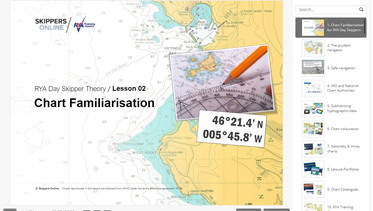
Day Skipper & Yachtmaster theory courses - 20% off
Online RYA theory courses with a great discount courtesy of Crewseekers.
Skipper required for Lagoon 440 Catamaran
More information
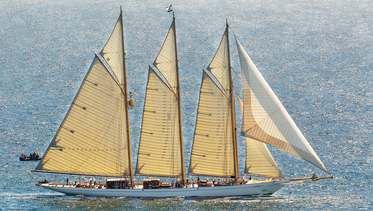
Training for a career at sea?
What qualifications do you need to get the jobs you want?
we love sailing as much as you do
Crewseekers is run by experienced, professional sailors offering a friendly and helpful service to yacht crew and owners. We are the original yacht crew introduction agency – established for over 25 years, offering amateur and professional sailing opportunities throughout the world.

- Find A School
- Certifications
- North U Sail Trim
- Inside Sailing with Peter Isler
- Docking Made Easy
- Study Quizzes
- Bite-sized Lessons
- Fun Quizzes
- Sailing Challenge

What Is Your Role on a Boat?
By: Zeke Quezada, ASA Charter , Learn To Sail
Your ASA sailing education will prepare you to be a skipper on a sailing vessel and with that comes the responsibility of keeping your crew safe and ensuring the safety of the vessel you are sailing. You will also have a crew and responsibilities are spread among those on the boat with you.
What type of sailor are you and what role do you take on the boat?
The Roles on a Boat
When on a charter sailing vacation your group will share responsibilities. While the skipper and mate will take the lead on running the boat, many important tasks are available for the crew to handle. These roles can be rotated and the entire crew can become familiar with the complete operation of the vessel.

Assure the safety of the crew and the safety of the boat and to ensure that the way the boat is handled complies with all relevant rules and regulations.

Performs engine checks and routine inspections of systems.
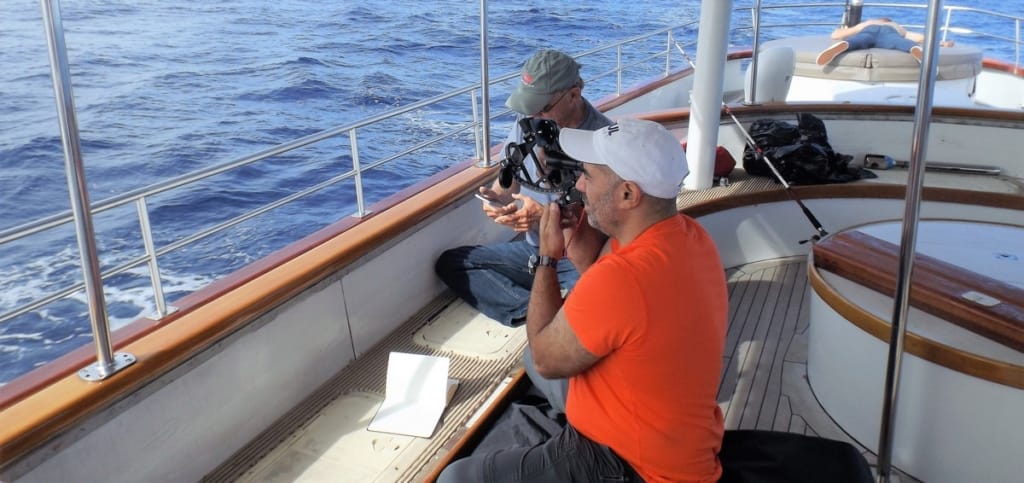
Checks weather forecasts, plan sailing routes and courses, and monitors the boat’s position under way.
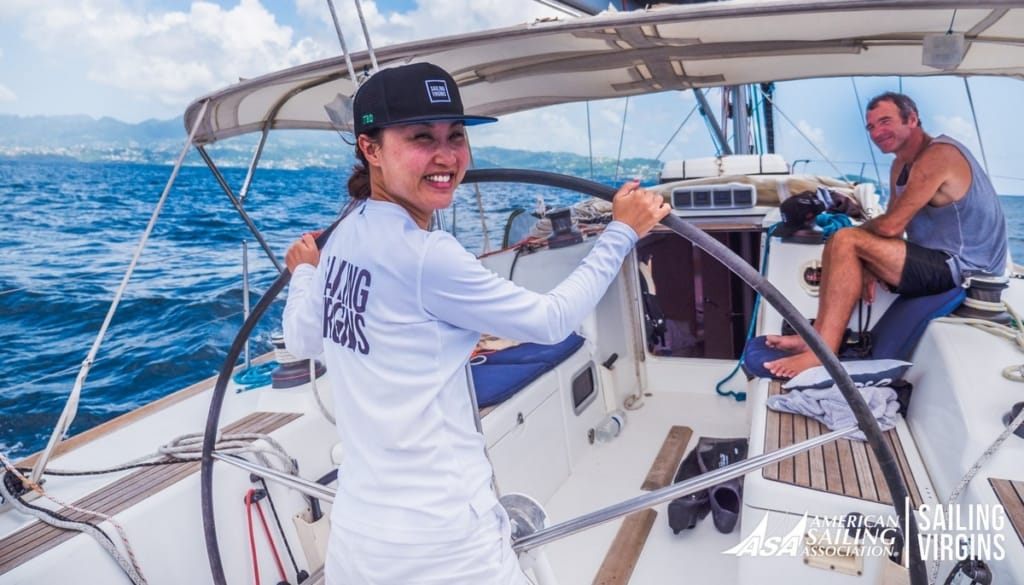
Steers the boat to the courses supplied by the navigator.
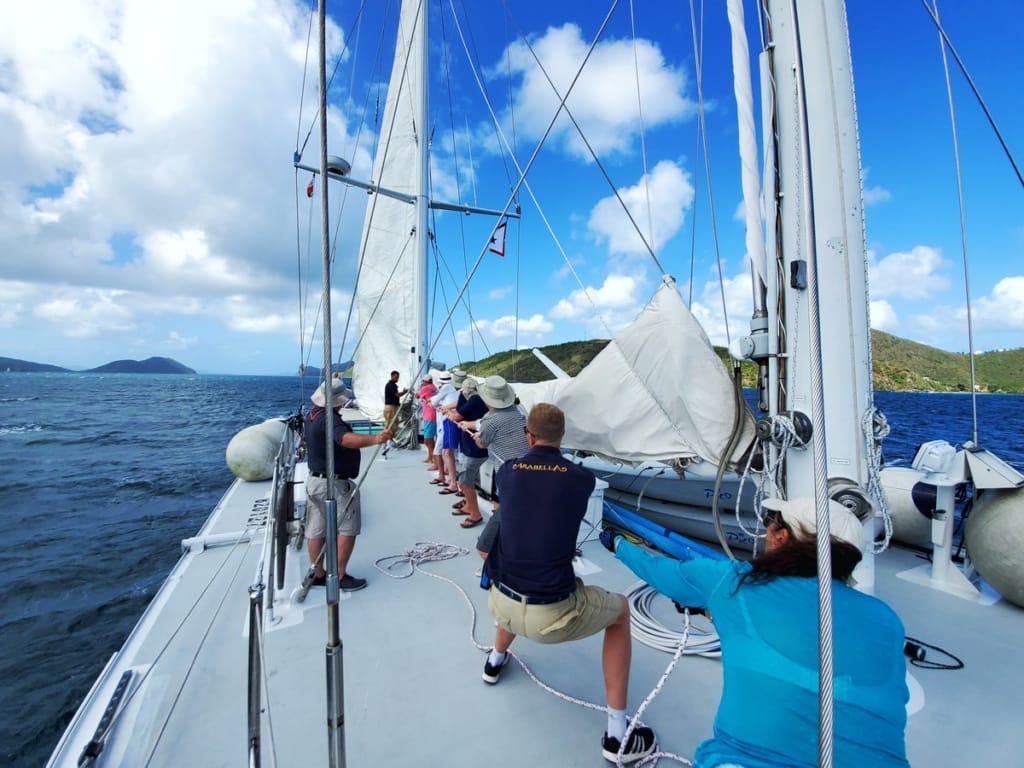
Supervises sail trim to suit the course being steered.
Dinghy Captain
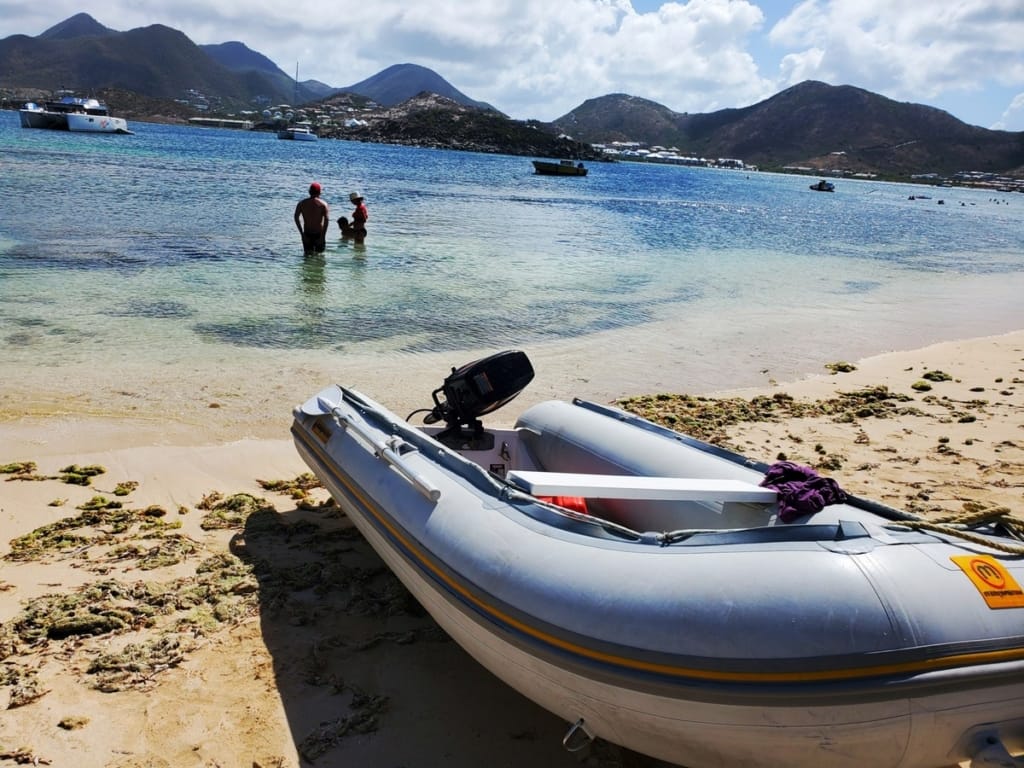
Ensure the dinghy is clean, dry, inflated, fueled, and equipped with safety gear and that it’s properly secured at all times.
The Crew Responsibilities

The crew’s primary responsibility is to follow the skipper’s orders for the safe operation of the boat. Even if a crew is made up of family members, including children, the skipper needs to establish order for the sake of safety.
These Three Asa Certification Courses Will Prepare You to Take on Any Role on a Sailboat:
ASA 101 – Basic Keelboat Sailing will prepare you to skipper a sloop-rigged keelboat of approximately 20 to 27 feet in length by day in light to moderate winds (up to 15 knots) and sea conditions. Knowledge of basic sailing terminology, parts and functions, helm commands, basic sail trim, points of sail, buoyage, seamanship and safety including basic navigation rules to avoid collisions and hazards. Auxiliary power operation is not required.
ASA 103, Basic Coastal Cruising will prepare you to skipper a sloop-rigged auxiliary powered (inboard or outboard engine) keelboat of approximately 25 to 35 feet length by day in moderate winds (up to 20 knots) and sea conditions. Knowledge of cruising sailboat terminology, basic boat systems, auxiliary engine operation, docking procedures, intermediate sail trim, navigation rules, basic coastal navigation, anchoring, weather interpretation, safety and seamanship.
ASA 104, Bareboat Cruising covers 55 skills that must be completed to earn certification. In addition to being able to skipper a sloop-rigged, auxiliary powered keelboat of approximately 30 to 45 feet in length during a multi-day cruise upon inland or coastal waters in moderate to heavy winds (up to 30 knots) and sea conditions you will have knowledge of provisioning, galley operations, boat systems, auxiliary engine operation, routine maintenance procedures, advanced sail trim, coastal navigation including basic chart plotting and GPS operation, multiple-anchor mooring, docking, health & safety, emergency operations, weather interpretation, and dinghy/tender operation.
Related Posts:

- Learn To Sail
- Mobile Apps
- Online Courses
- Upcoming Courses
- Sailor Resources
- ASA Log Book
- Bite Sized Lessons
- Knots Made Easy
- Catamaran Challenge
- Sailing Vacations
- Sailing Cruises
- Charter Resources
- International Proficiency Certificate
- Find A Charter
- All Articles
- Sailing Tips
- Sailing Terms
- Destinations
- Environmental
- Initiatives
- Instructor Resources
- Become An Instructor
- Become An ASA School
- Member / Instructor Login
- Affiliate Login
- Advertising
- Find the Magazine
- Good Jibes Podcast
- Boat In Dining
- Sailboat Charters
- Business News
- Working Waterfront
- Youth Sailing

FIND A BOAT. FIND CREW.

COME TO THE FALL CREW PARTY: September 4th!
More Info Click Here .
ADD YOUR NAME TO THE SKIPPER OR CREW LISTS BELOW — FOR ANYONE WHO WANTS TO SAIL MORE
Are you looking to connect to sailing? Looking for a boat to crew on, planning to go cruising, organizing your racing season, want to sail in the Baja Ha-Ha , or would like company for a pleasant day on the Bay? Sign up to find crew or be crew. It's free and instantaneous!
CONTRIBUTE! The Crew List is a free service to connect boat owners and crew. Free with donations accepted! If you are able to support the Crew List and Latitude 38 with a contribution, click here .
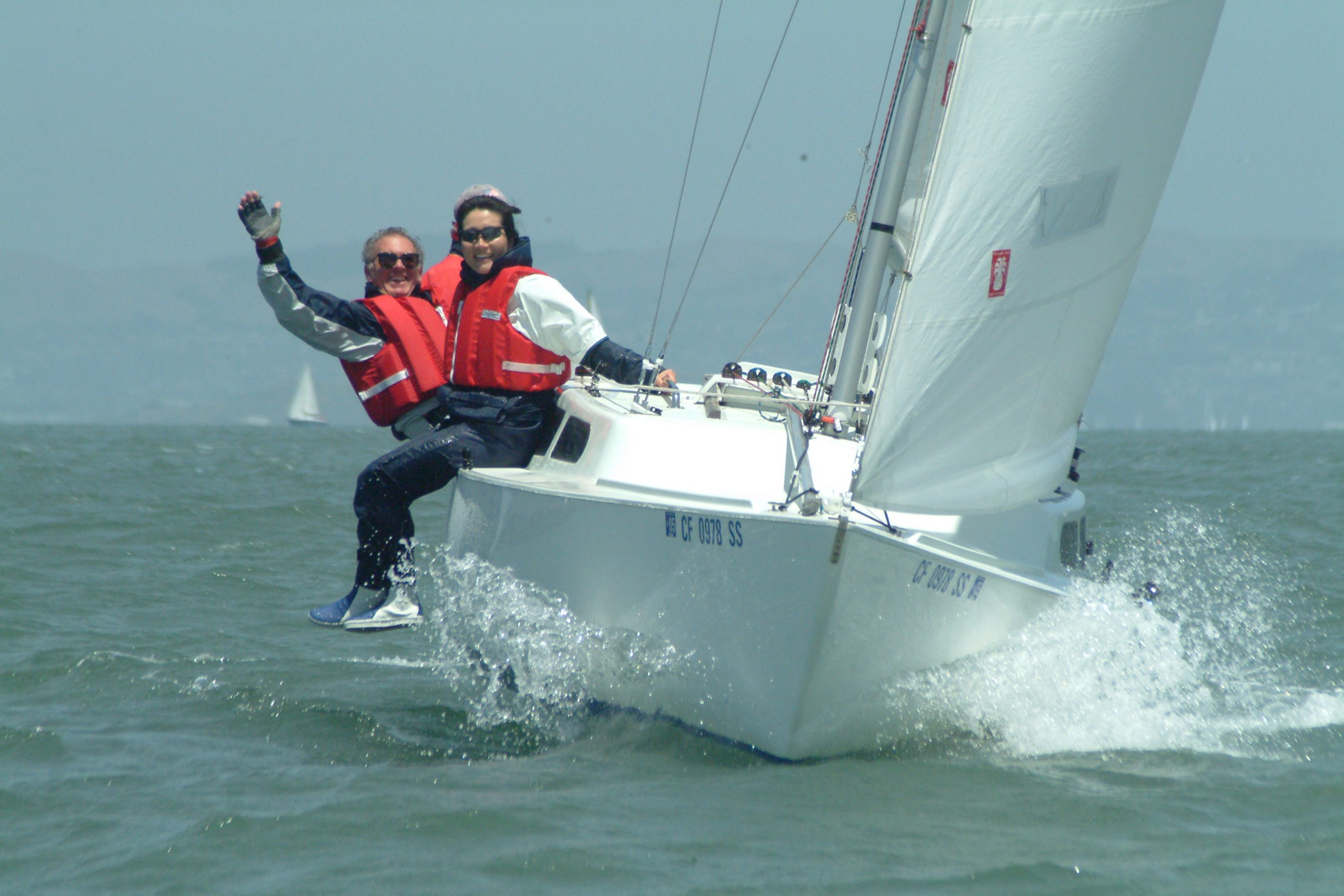
I Want to Crew
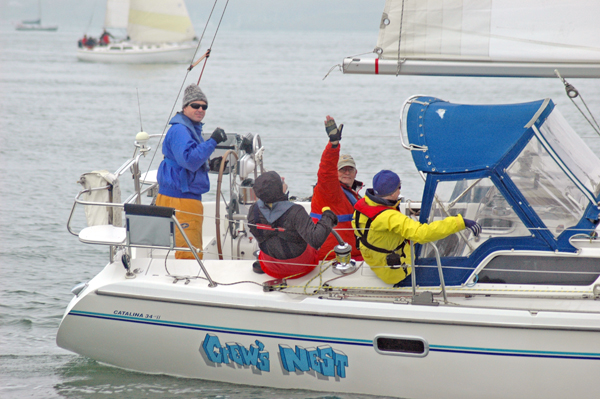
I'm a Skipper and Need Crew
Read about Jimmy Peter's Crew List ride from San Diego to the Marquesas here .
DISCLAIMER: I understand that Latitude 38 offers the Crew List as a service only. Latitude 38 neither makes nor implies any guarantee, warranty or recommendation regarding the character of individuals participating in the Lists, the condition of their boats, or any weather or sea conditions I may encounter. I must judge those things for myself. I also understand that Latitude 38 reserves the right to remove inappropriate listings without notice to the lister.

36 Boating Team Names
Trim the sails and weigh the anchor, it’s time to set sail with brand new custom gear for your team. Outfit your whole crew with custom t-shirts and cruise ahead of the competition with these awesome boating team names that will help you stay afloat.
35 Boating Team Names
Sea Witches
Blazing Paddles
Hope it Floats
Havin’ a Row
Vitamin Sea
Boaty McBoat Team
Saved by the Bail
Without a Paddle
All Oar Nothing
Shore Thing
River Raiders
Now Streaming
Come Sail Away
Jolly Rogers
Feeling Sailfish
All Hands on Deck
Life of a Sailsman
Sailin’ with the Buoys
Just Add Wind
Pier Pressure
Feeling Nauti
Seas the Day
Frayed Knots
Moon and Starboard
Row! Row! Row!
Oh Captains, My Captains
Smile and Waves
Related Posts
- 32 Car Wash Team Names
- 40 Oktoberfest Sayings and Slogans
- 24 Multiple Myeloma Sayings & Slogans
- Motivational Martial Arts Quotes and Sayings
- Jingle Bell Run Sayings & Slogans
Grant Shumaker
Grant is the Senior Copywriter at Custom Ink. He loves stories of all kinds and actively seeks to enthrall everyone around him with exciting tales, even if they’re about everyday events. Outside of storytelling, Grant loves to immerse himself in movies, television, books, and games, as well as go exploring in order to draw inspiration for the worlds in his mind.
Leave a Comment
Save my name, email, and website in this browser for the next time I comment.
- AROUND THE SAILING WORLD
- BOAT OF THE YEAR
- Email Newsletters
- America’s Cup
- St. Petersburg
- Caribbean Championship
- Boating Safety
- Ultimate Boat Giveaway

The Pressure of Picking Sailboat Names
- By Gary Jobson
- Updated: December 13, 2011
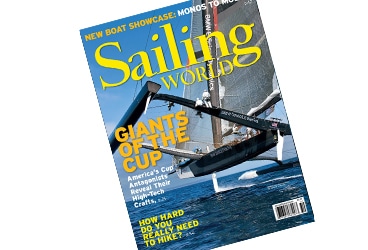
Sailing World: October 2009
Coming up with sailboat names is always a challenge, especially for anxious new owners. It’s an undertaking that should be handled with great care. Sailboat names, as trivial as it may seem at first, define the essence of a boat, its owner, and often its legacy. As I travel around the waterfront I am sometimes intrigued by boat names. Other times I’m mystified. I’ve named many boats over the years, and the approach that I always take is to first make a list of categories: patriotic, geographic, legacy, bold, whimsical, from literature, movies, science, lifestyle, and a person to honor. A dictionary is a good place to start, but for inspiration there are lists of sailboat names found in yacht club registries, Lloyd’s Registry, and history books, to name a few.
The graphic presentation and typeface should fit the word or words being used, and for this, a graphic designer will be your best asset. It is nice to have a unique look or logo that might also be used on a spinnaker or the hull. I particularly enjoy seeing boats that coordinate hull, sail, and crew clothing graphics. All professional sports teams work at making bold statements, and so, too, should we. A club’s burgee and hailing port can also be integrated into the graphics as a way to promote your local sailing scene at away regattas.
Naming a boat can be more complicated when partners are involved, so be patient, the process can take months. I was once part of a group of four owners trying to name a boat, and we never could agree. Once we reached a deadlock, we decided to have an outside party come up with a name. It worked.
Many owners carry over a name from one boat to the next, which helps create a history that new and old sailors can appreciate. Two high-profile owners from England, for example, have owned more than 30 boats in their careers— Yeoman and Oystercatcher —and most everyone on the Solent instantly associates these boats with their owners and the many crew that have crossed their decks. Tom Hill’s latest Titan is No. 15 in the Titan pedigree. That’s a mighty impressive run.
Legacy names prevail long after their heydays. Several come quickly to mind: Merrythought , Gem , Nitemare , Palawan , Thunderhead , Kodiak , Ondine , Kialoa , Donnybrook , Matador , and Pyewacket . Other owners have themes for their boats: one of my favorites is that of Jim Swartz, who named his boats afer James Bond characters like Moneypenny and 007 . George David has had fun with Idler and Rambler . Two-word names seem to add to the importance of a yacht: Running Tide ,_ Northern Light_, Stars & Stripes , and Blue Yankee are boats that come readily to mind.
There is often the question of whether a boat should be renamed when a new owner acquires it. I believe a new name isappropriate. Ted Turner’s Tenacious was originally named Dora IV afer the wife of its original owner. Ted was a ladies’ man, but that would never fly. Plus, Tenacious better suited his dynamic personality. Ted owned two boats named Tenacious .
I have named my last three boats in honor of great yacht designers of the past. I owned two boats named Whirlwind , a name that aptly describes my lifestyle, but more importantly was a tribute to L. Francis Herreshoff, who, in 1930, designed a double-ended J Class boat of the same name. The crew only won one race that America’s Cup season, but they kept trying. My first Whirlwind was an L. Francis Herreshoff-designed knockabout from 1932, the second was a Sabre 402. My most recent boat, a NYYC Swan 42, is Mustang , a name I borrowed in honor of Rod Stephens’ series of personal yachts.
Over the years, trends have greatly influenced the names of legendary boats. The 12-Meter era featured bold names such as Vim , Valiant , Intrepid , and Courageous . Then there was the patriotic era of the America’s Cup, with names like Stars & Stripes , Freedom , Liberty , Australia II , New Zealand , and America3 . The exponent following Bill Koch’s America3 was a fun nod to science.
The America’s Cup has since been taken over by corporate branding; this is a trend I hope goes away so we can get back to more memorable names. Thomas Lipton challenged for the America’s Cup in part to promote his Lipton tea, and yet he called his boats Shamrock for good luck. He was Irish, after all. During the Great Depression, owner Harold Vanderbilt named his J Class boat Rainbow , letting the public know that brighter days were ahead.
Geography provides relevant names for boats. Olin Stephens raced the legendary Finnestere , named after a point of land in Spain. We had Easterner , a 12-Meter, from the Eastern YC. There is, of course, Atlantic , which set a record in the 1905 Transatlantic Race under skipper Charlie Barr. Even the founder’s of the New York YC were smart in naming their revolutionary schooner America before sending it to challenge the British.
Today, it seems, there are many offbeat names attached to boats. In my hometown of Annapolis, one Etchells sailor was so grateful for the use of household funds to buy a boat he smartly named it My Wife’s the Best . And on the flip side, who can forget the famous 50-footer named FUJIMO ? If you haven’t heard the origin of that name, ask around. Perhaps it’s a story best told on the rail.
Be careful with some names that might be too boastful if things do not work out. For example, in 1958, the 12-Meter Columbia was originally going to be called Swift , but the syndicate decided against it in case the boat was not as fast as its name implied. Defender was another name that appeared twice for the America’s Cup (1895 and 1983). Perhaps the name was a little too presumptuous. Aggressive names can be dangerous, too. In 1987, the America II syndicate nicknamed its boat The Eliminator , which sounded good until it was eliminated from the trials earlier than expected.
A name can be made up as well. In 2003, Ernesto Bertarelli showed up with Alinghi , a curious name that rolled off the tongue nicely. Today the word is a brand name of its own, but at first it seemed kind of whimsical. It is a word that Bertarelli made up in his youth. Later, he created a definition for it: “joy, dreams, a certain lightness, but also speed and action.” After the multihull challenge we are scheduled to see for the 33rd America’s Cup, I wonder if Alinghi will take on a different meaning.
Movies and entertainment can provide the inspiration for a name, but be careful of trendy names that may fade in meaning as the years roll by. Still, they can be playful. I recently cruised on a 90-foot Fife built in 1914 named Sumurun . The name comes from a popular English play from the period. Sumurun was the mistress of the Sheik in a play.
During a recent Newport to Bermuda Race, I made note in an Internet report that there were some strange names of boats in the race: Zippity Doo Dah ,_ Nasty Medicine_, The Cone of Silence , Fat City Too , Better Than…. , and Euro Trash Girl . It’s great to see there are owners who appreciate fun and interesting names such as these.
Once you decide upon a name, make the most if it with crew clothing, stationary, and maybe even stickers for the car. A well-named boat can quickly attract a following, and soon crew might be sailing for the experience and the gear. People like to name lots of things. We give nicknames to our friends and foes, and we name our children and our pets. In some places, like Bermuda and Nantucket, people even name their houses. Boats are special and deserve good names that fit the owner’s persona.
- More: Sailboats
- More Sailboats

Nautor Swan Has A New Pocket Rocket

Pogo Launches its Latest Coastal Rocket

A Deeper Dive Into the Storm 18

2024 Boat of the Year Best Recreational Racer: Z24

Smart Polars Are Here

The Skimming Superyacht

Improve Your Weeknight Race Results
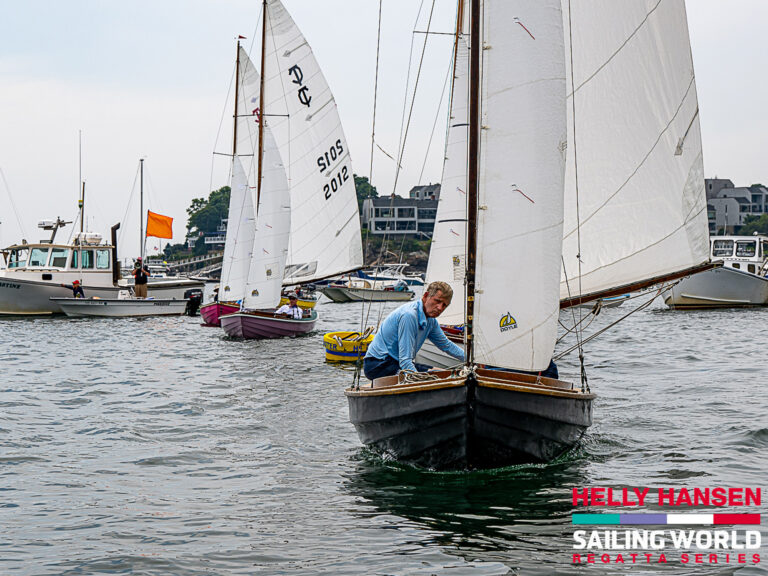
Townie Showdown in the Harbor

- Digital Edition
- Customer Service
- Privacy Policy
- Terms of Use
- Cruising World
- Sailing World
- Salt Water Sportsman
- Sport Fishing
- Wakeboarding
- TV & Film
- Say Maaate to a Mate
- First Impressions - The Game
- Daily Ladness
- Citizen Reef
To make sure you never miss out on your favourite NEW stories , we're happy to send you some reminders
Click ' OK ' then ' Allow ' to enable notifications

Captain of boat that helped rescue passengers on sunken £14m yacht speaks out on moment it went underwater
Karsten borner found the life raft with surviving passengers, revealing what him and his crew went through in the middle of the storm.
Joshua Nair
The valiant captain of a boat that helped to rescue 15 passengers and crew from the doomed Bayesian superyacht has described what he saw when he got to the sinking ship.
Karsten Borner spoke about his experience while manning his boat, which was close to colliding with the £14 million vessel in the midst of a tornado hitting the coast of Sicily Monday (19 August) morning.
The horrid weather capsized the 55-metre Bayesian superyacht, which was also carrying 22 passengers and crew at the time, with six still currently missing , as authorities continue their search.
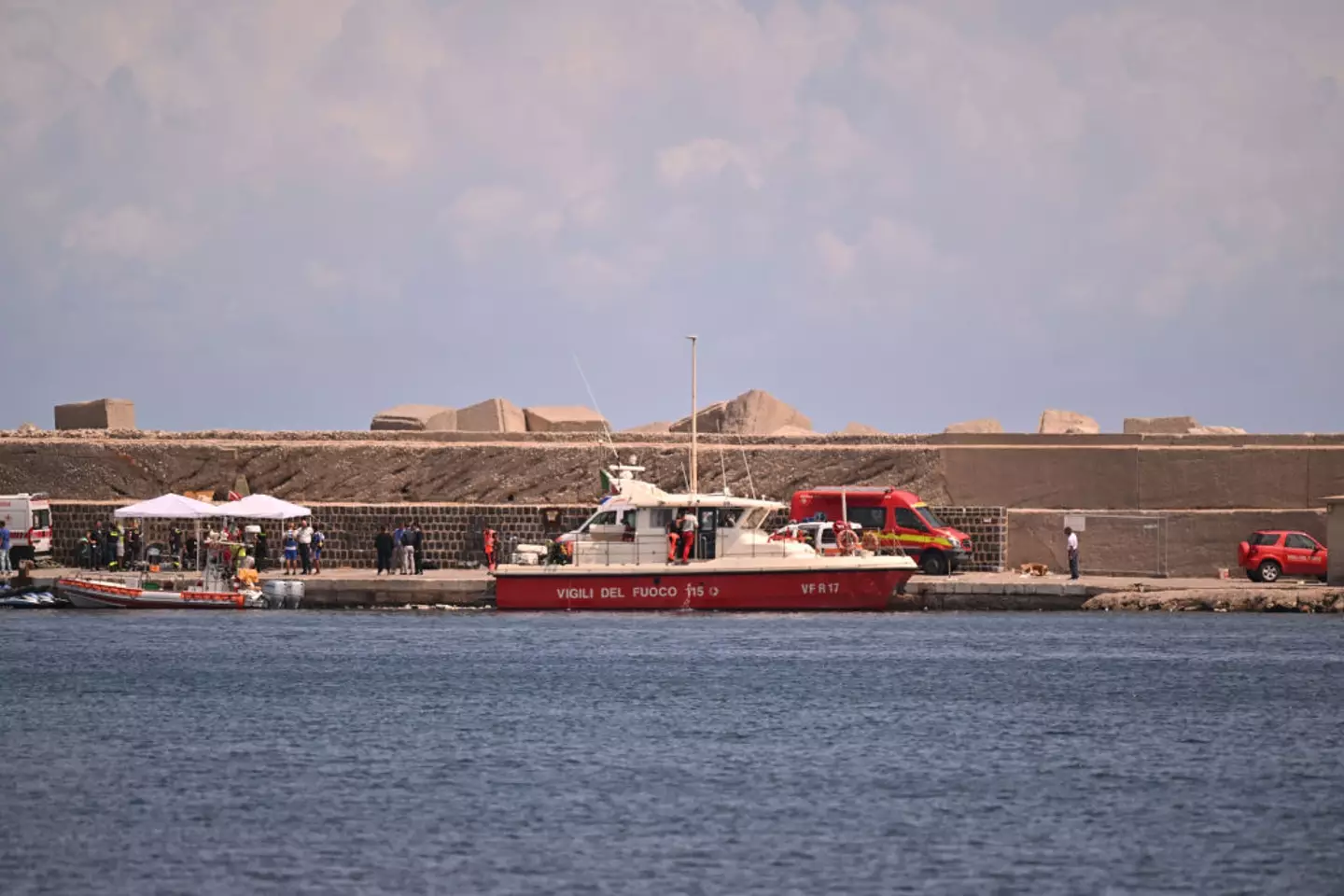
One of the missing people has been confirmed to be the owner of the vessel, UK tech tycoon Mike Lynch , known as the ' British Bill Gates', along with his 18-year-old daughter Hannah. His wife, Angela, made it out safely.
Most passengers were in their cabins when the tornado hit, though divers sent down to look for bodies claimed to have found 'corpses' in the vessel's portholes .
Very few people saw the state of the superyacht in the early morning yesterday, but Borner was very vivid in his recollection of the moment, as he explained to Global News: "We managed to keep the ship in position, and after the storm was over, we noticed that the ship behind us was gone."
Even though it was anchored up near the Porticello port in Palermo, the heavy rainfall caused the superyacht to start sinking as it filled with water, as he said that Lynch's yacht 'went flat on the water and then down'.
Borner was manning the Sir Robert BP as him and his crew were slapped with strong gusts of wind and torrential rainfall, meaning that they anchored up near the Porticello port as well.
Borner continued: "There was a light and we saw that the ship was aside and then we saw a triangle. So I think she went back down," before adding that he had noticed the superyacht vanish just before seeing a flare in the water with rising smoke.
There was a life raft out at sea with 15 people inside, including a one-year-old baby, as Borner thought quickly to inform the coastguard, who came out to guide the raft to safety.
Following the capsizing, Borner said that four people were injured, while three needed medical treatment .
The mum of the rescued one-year-old, Charlotte Golunski, says flooding in the yacht woke her up, with thunder and lightning leaving the yacht rocking according to her and her partner, James Emslie.

Young Sophia was clutched onto as Charlotte revealed her side of things to la Repubblica: “I held her afloat with all my strength, my arms stretched upwards to keep her from drowning.
“It was all dark. In the water I couldn’t keep my eyes open."
James wasn't able to find his family after initially being swept away at sea.
Seven tourists and crew didn't make it on the lifeboat, with one body, Chef Ricardo Thomas found among the wreckage.
Most of the missing people are passengers, as charterers said there were 12 guests and 10 crew sailing at the time.
Topics: Health , News , Travel , Weather , World News , Bayesian yacht
Joshua Nair is a journalist at LADbible. Born in Malaysia and raised in Dubai, he has always been interested in writing about a range of subjects, from sports to trending pop culture news. After graduating from Oxford Brookes University with a BA in Media, Journalism and Publishing, he got a job freelance writing for SPORTbible while working in marketing before landing a full-time role at LADbible. Unfortunately, he's unhealthily obsessed with Manchester United, which takes its toll on his mental and physical health. Daily.
@ joshnair10
- Brother of missing billionaire on yacht says missing people could still be alive due to 'air pockets'
- Inside the luxury £30m yacht that sank in Italy with billionaire Mike Lynch on board
- Pilot's last words revealed before tragic Brazil plane crash killed all 62 passengers on board
- Eerie dystopian footage shows Dubai underwater as two years' worth of rain hits holiday destination
Choose your content:

Heart surgeon shares the four things he 'absolutely avoids' in life that can cause serious health issues
The cardiac surgeon warns us to 'be conscious about what you're putting in your mouth'.

Woman issues major warning after finding out how much she was charged for bottle of tequila in nightclub
Drink spiking is a serious danger which many people have experinced.

Brit who is 'world's oldest man' gave incredible answer when asked for the 'secret to long life'
The oldest man in the world has given an incredible answer when asked about the secret to old age.

David Beckham reveals last words Sven-Göran Eriksson said to him as pair said goodbye
Former england star david beckham paid tribute to his manager.

IMAGES
COMMENTS
The skipper is responsible for the safety of the yacht and the crew's welfare. However, sailing a boat successfully requires teamwork from the skipper and the crew. This will ensure that all maneuvers—such as leaving a mooring, hoisting sails, changing tacks, reefing, or entering a marina—can be completed with maximum enjoyment and minimum stress. Boat Captain/Skipper It may come as a ...
So, get ready to embark on a journey to find the perfect nautical team name that will make your group stand out from the rest! Catchy Nautical Team Names. 1. ⚓️ Anchors Aweigh 2. Wave Riders 3. Sea Explorers 4. Ocean Warriors 5. ⛵️ Sail Away Squad 6. Neptune's Crew 7. Sea Stars 8. ⚓️ Mariner Mavericks 9. ♀️ Rowing Rebels 10 ...
The skipper's duties include: Planning and executing the sailing itinerary. Ensuring the boat is properly maintained and equipped. Making decisions regarding navigation, weather, and safety. Managing the crew and assigning tasks. Ensuring all crew members are trained and competent in their roles.
Sailing is an exciting and competitive sport that brings people together on the water. Choosing a unique and catchy team name can be tricky but will ultimately set your team apart from others. Explore these cool, funny, and pun-filled sailing team name ideas to find the perfect name for your crew.
Stew/Deck - This is a combined role between a Steward and Deck crew member. This role straddles both the interior and exterior of the yacht and is a popular choice when needing additional staff on board. Solo Steward/ess - Typically found on much smaller vessels, the solo steward will be the only steward on board.
Deckhand. Deckhands are the workhorses of the boat's crew. Deckhands have a range of general responsibilities, and their main task is to keep the boat in ship-shape. This includes cleaning, painting, general maintenance and possibly driving tenders or kit such as jet skis for guests. They may also be required to assist with cleaning, cooking ...
It's the captain's job to direct the ship and manage all of its operations. On a sailboat, the captain is responsible for complying with regulations and navigating, along with steering and trimming the sails if the crew is small. 2. First Mate. The first mate, or chief officer, is second in command below the captain.
A sailboat is by definition a vessel of leisure. People don't sail to transport cargo, or transport passengers anymore. Most times a sailboat is underway to show people a good time. When skippers start to bark orders and assert authority, bad feelings abound. By the time they get back to the dock and it is cocktail hour, a sailboat crew can ...
Seafarer's professions and ranks. Seafaring is a tradition that encompasses a variety of professions and ranks. Each of these roles carries unique responsibilities that are integral to the successful operation of a seafaring vessel. [ 1] A ship's crew can generally be divided into four main categories: the deck department, the engineering ...
The Second and Third Engineers report directly to the Chief Engineer. They assist in maintaining all mechanical and electrical operations of the yacht. 2nd Engineer. €3,000 - €10,000. 3rd Engineer. €2,500 - €6,500. Sole Engineer. €3,500 - €12,000. Motorman.
Hours, Salaries, and Expectations. Yacht crew is a service job at its core, and every yacht owner is looking for service-oriented people who understand how to deliver a hotel-quality living and restaurant-quality fine dining. Work experience in luxury hotels and restaurants is a big plus for some jobs, and makes breaking into yacht work easier.
The role: Responsible for the interior of a vessel. Responsibilities: Managing the interior team, food and beverage service, cabin preparation, liaising with guests, interior detailing, training of interior crew, upkeep of inventories and provisioning, orchestrating guest activities. Reports to: Captain. The chief stewardess is the head of the ...
Read on to learn what your crew wants you to remember each race! Photo by Sharon Green. While it's important to master your position on the boat, it's equally as important to understand what's going on in other domains and what you can do to make your teammates' life easier and help the boat sail smoothly. We reached out to a mix of ...
Crew Boat Positions. Sailing Duties. Tacticians. Driver. Bowman. Pit. ... A sailing team's name can differ among boat types. Normally they are called a "crew," specifically on crew boats where the members are very close together and are forced to work as a team more than any other boat. Teams in a competition can also just be called ...
While boat-dependent, all positions are some combination of the responsibilities of driver, bow, tactician, trimmer, and pit. The driver makes the final decisions and steers, while the other crew members play various roles providing information, trimming sails, and keeping the boat moving fast. The fundamental responsibilities of sailboat ...
The Cruising Crew List. This list is for Bay Cruising. If you're looking to sail on the Bay and meet some new friends, this is the list for you. Experience is less important than for racing and it's a good way to get your feet wet, so to speak. When a skipper contacts you to go sailing, it's a good idea to ask him about his experience.
Crewseekers is run by experienced, professional sailors offering a friendly and helpful service to yacht crew and owners. We are the original yacht crew introduction agency - established for over 25 years, offering amateur and professional sailing opportunities throughout the world. Amateur and professional yacht crewing positions available ...
These roles can be rotated and the entire crew can become familiar with the complete operation of the vessel. Skipper. Assure the safety of the crew and the safety of the boat and to ensure that the way the boat is handled complies with all relevant rules and regulations. Engineer. Performs engine checks and routine inspections of systems.
20000 ocean miles / 10000 coastal miles. I am Marco Adler, Turkish German, living in Marmaris, a province of Turkey, for the past 25 years. I have been sailing since 2007 and own 38 1st Beneteau (1985) sailing boat. Sailing is my passion,Sailing is my passion, so from time to time, I transfer boats as a skipper. ...
DISCLAIMER: I understand that Latitude 38 offers the Crew List as a service only. Latitude 38 neither makes nor implies any guarantee, warranty or recommendation regarding the character of individuals participating in the Lists, the condition of their boats, or any weather or sea conditions I may encounter. I must judge those things for myself.
Trim the sails and weigh the anchor, it's time to set sail with brand new custom gear for your team. Outfit your whole crew with custom t-shirts and cruise ahead of the competition with these awesome boating team names that will help you stay afloat. 35 Boating Team Names. Sea Witches. Blazing Paddles. Hope it Floats. Havin' a Row. Knot ...
Sailboat names, as trivial as it may seem at first, define the essence of a boat, its owner, and often its legacy. ... designed a double-ended J Class boat of the same name. The crew only won one ...
Buying a boat is a major purchase, and maintaining one takes a lot of work. Like a car, a boat becomes a part of the family, in a way.And every member of the family deserves a suitable name.
Karsten Borner found the life raft with surviving passengers, revealing what him and his crew went through in the middle of the storm The valiant captain of a boat that helped to rescue 15 ...
Name of surviving crew member confirmed by coastguard published at 18:24 British Summer Time 20 August. ... Twelve people were vacationing on Mike Lynch's yacht, alongside 10 crew members, when it ...